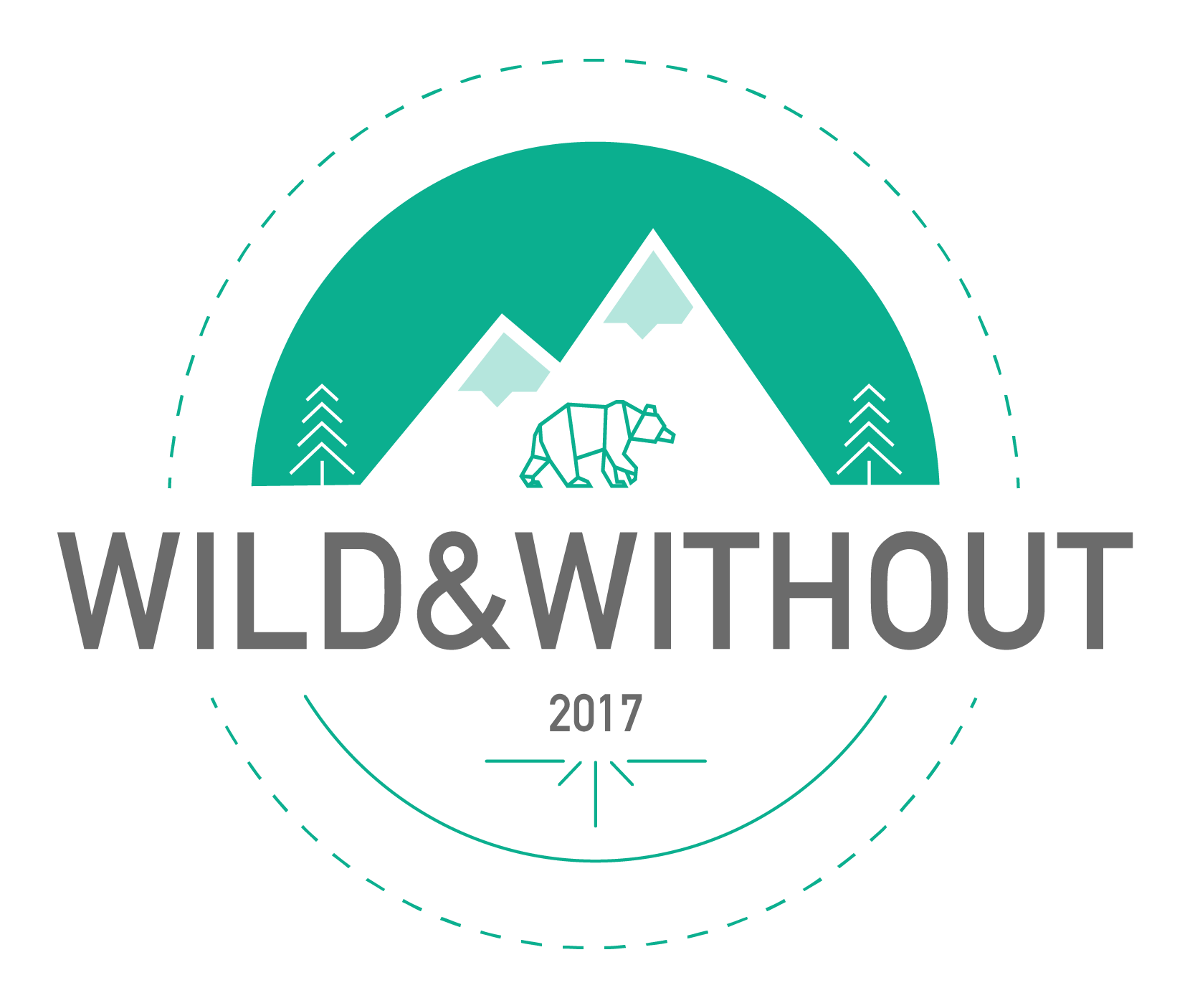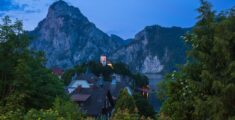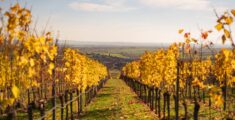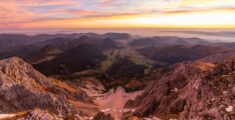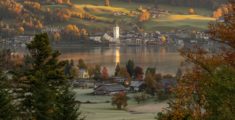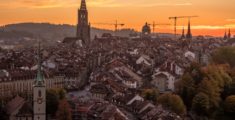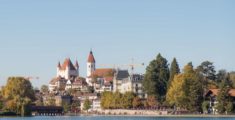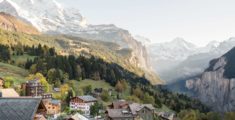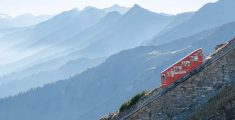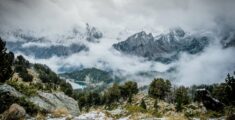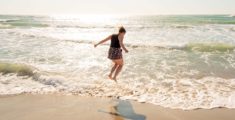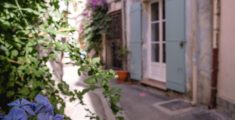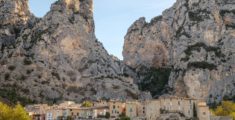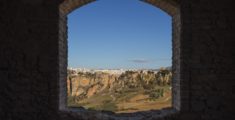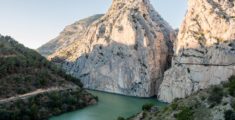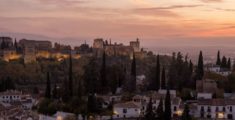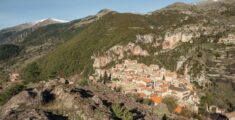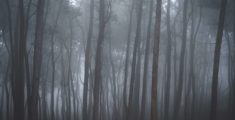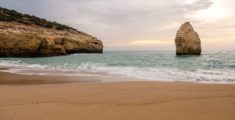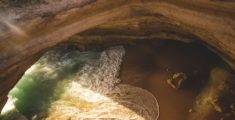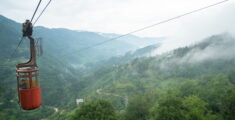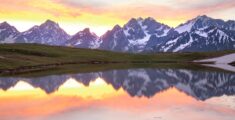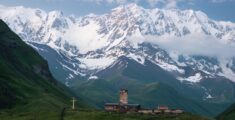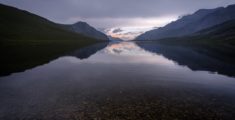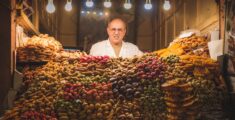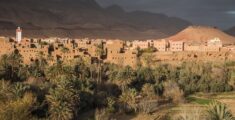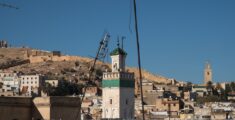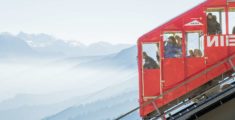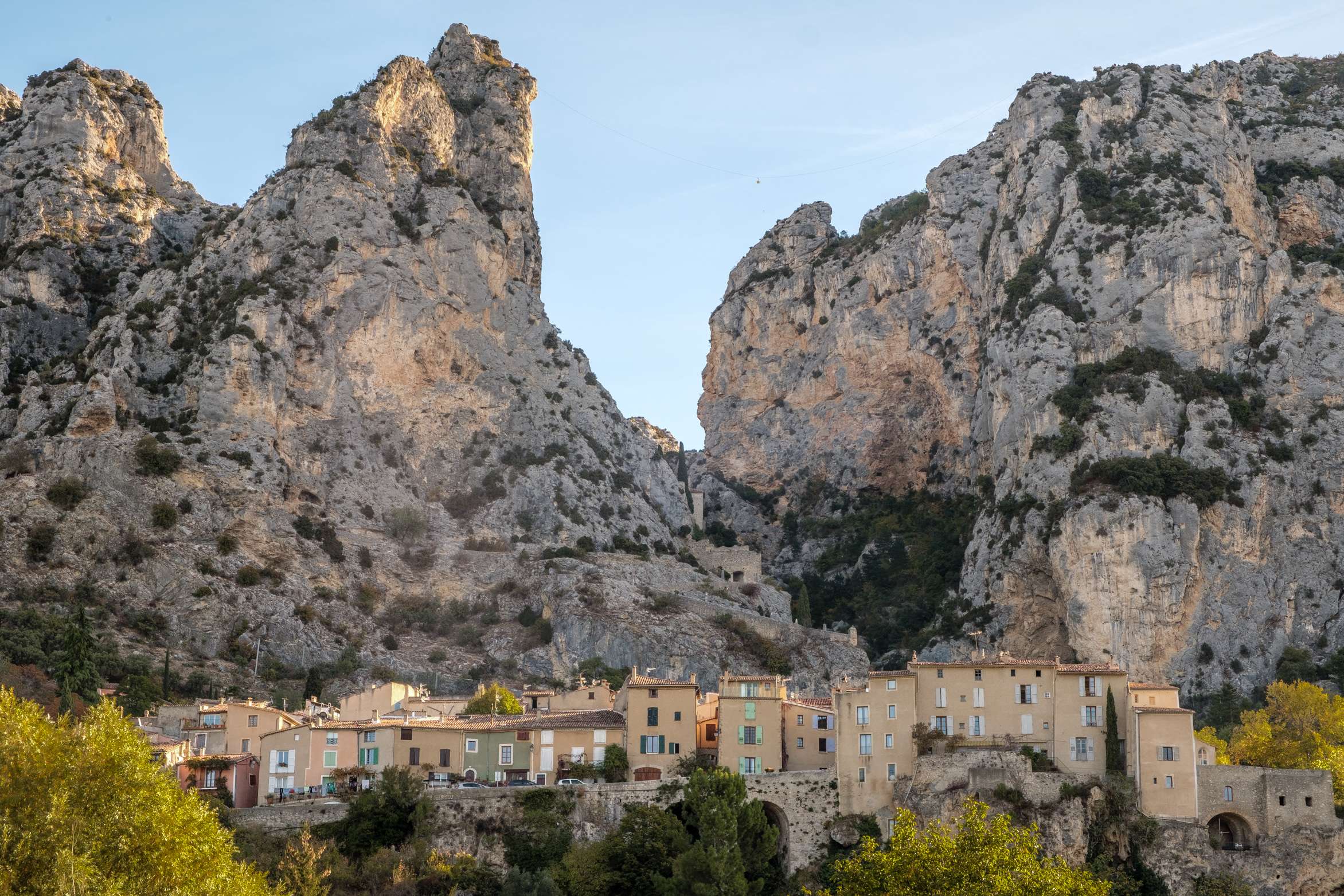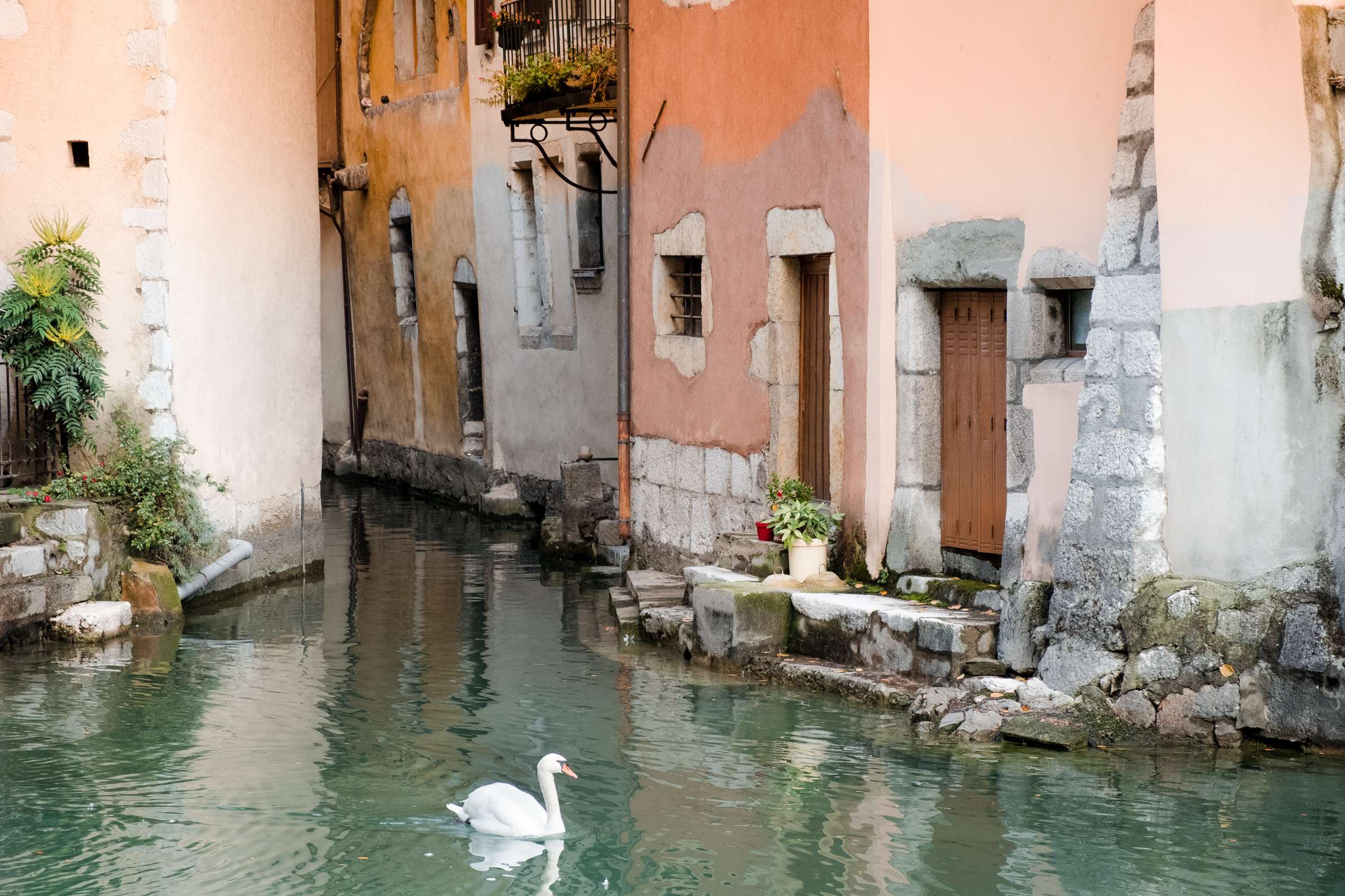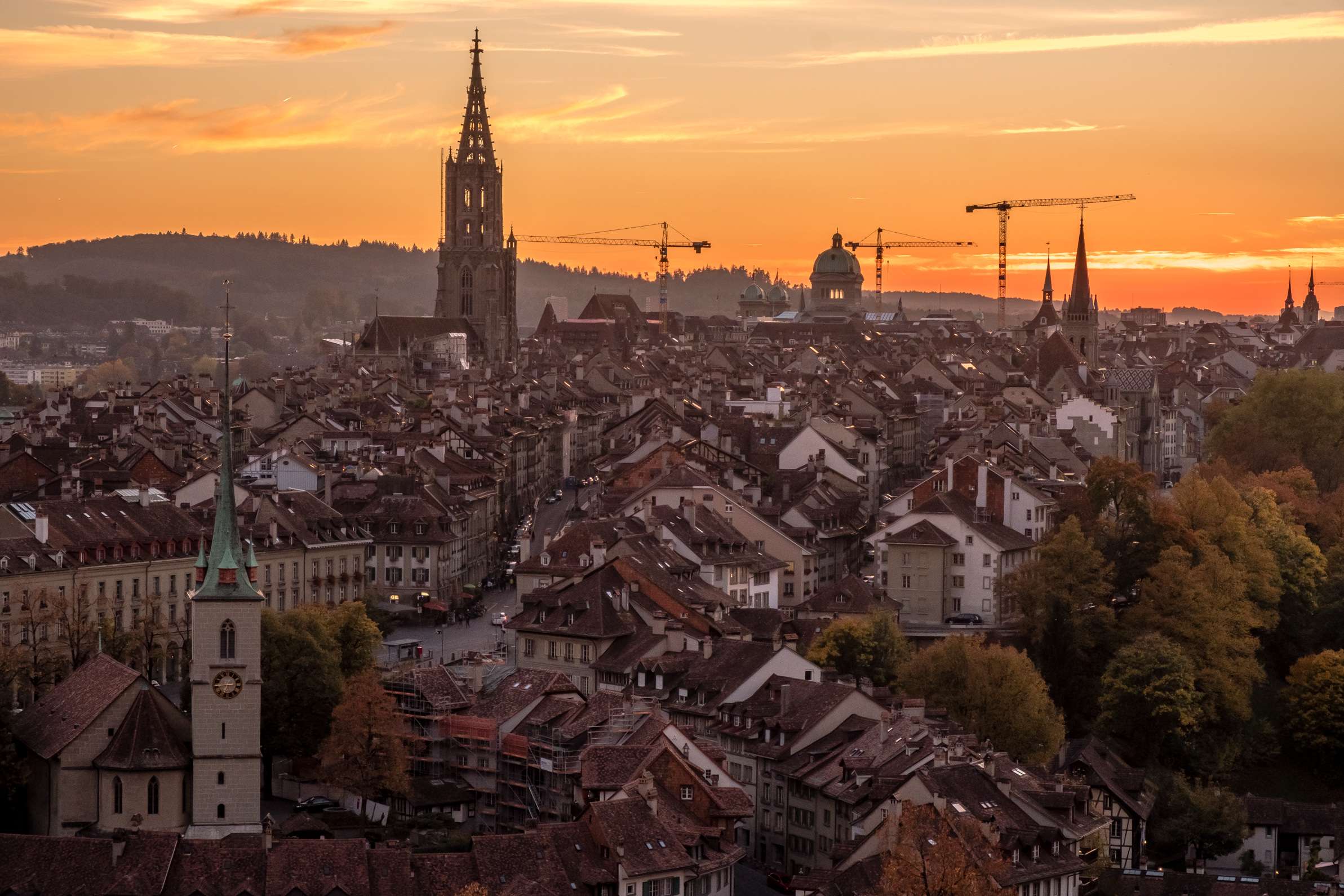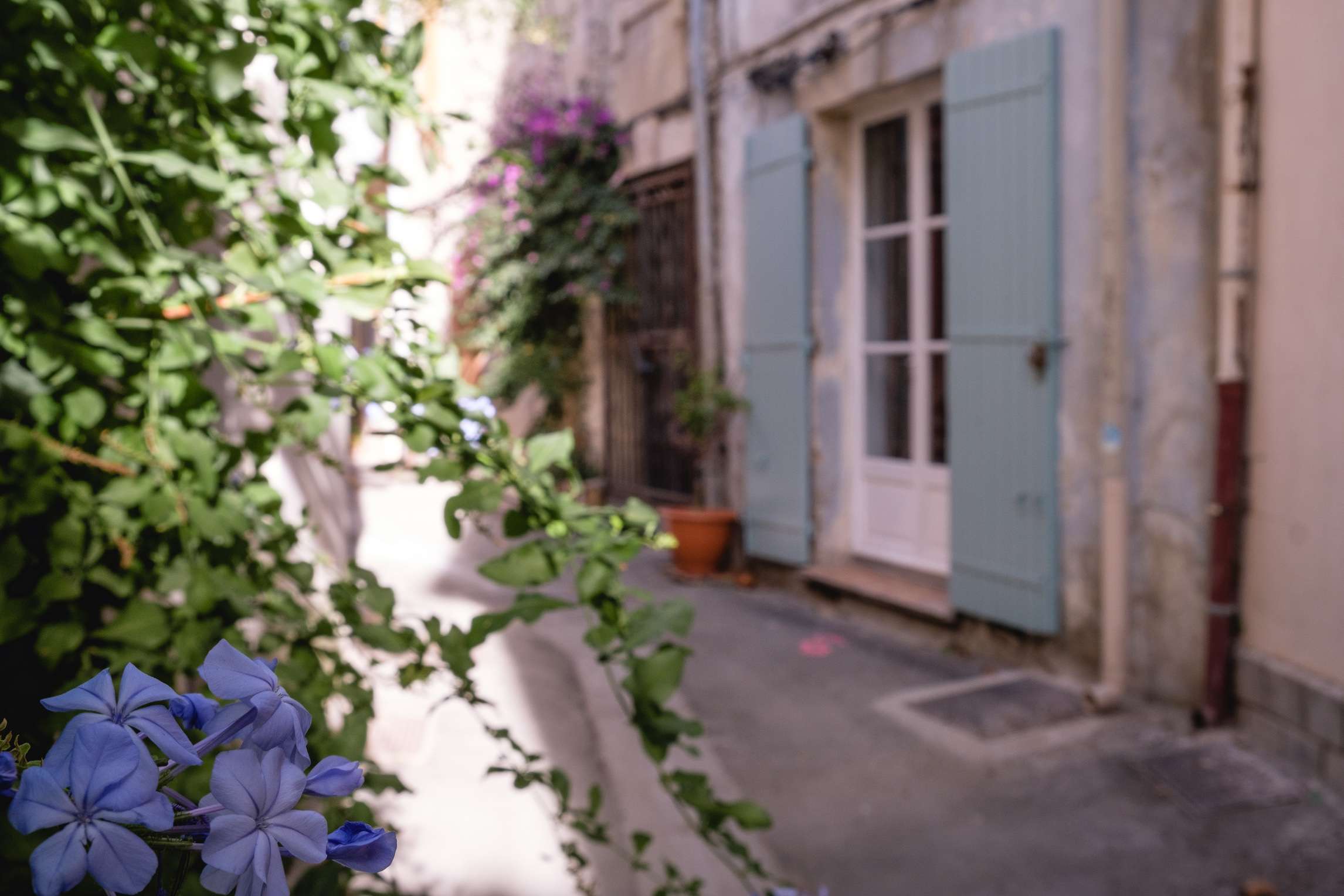The wonders of Ronda: A bridge between the eras
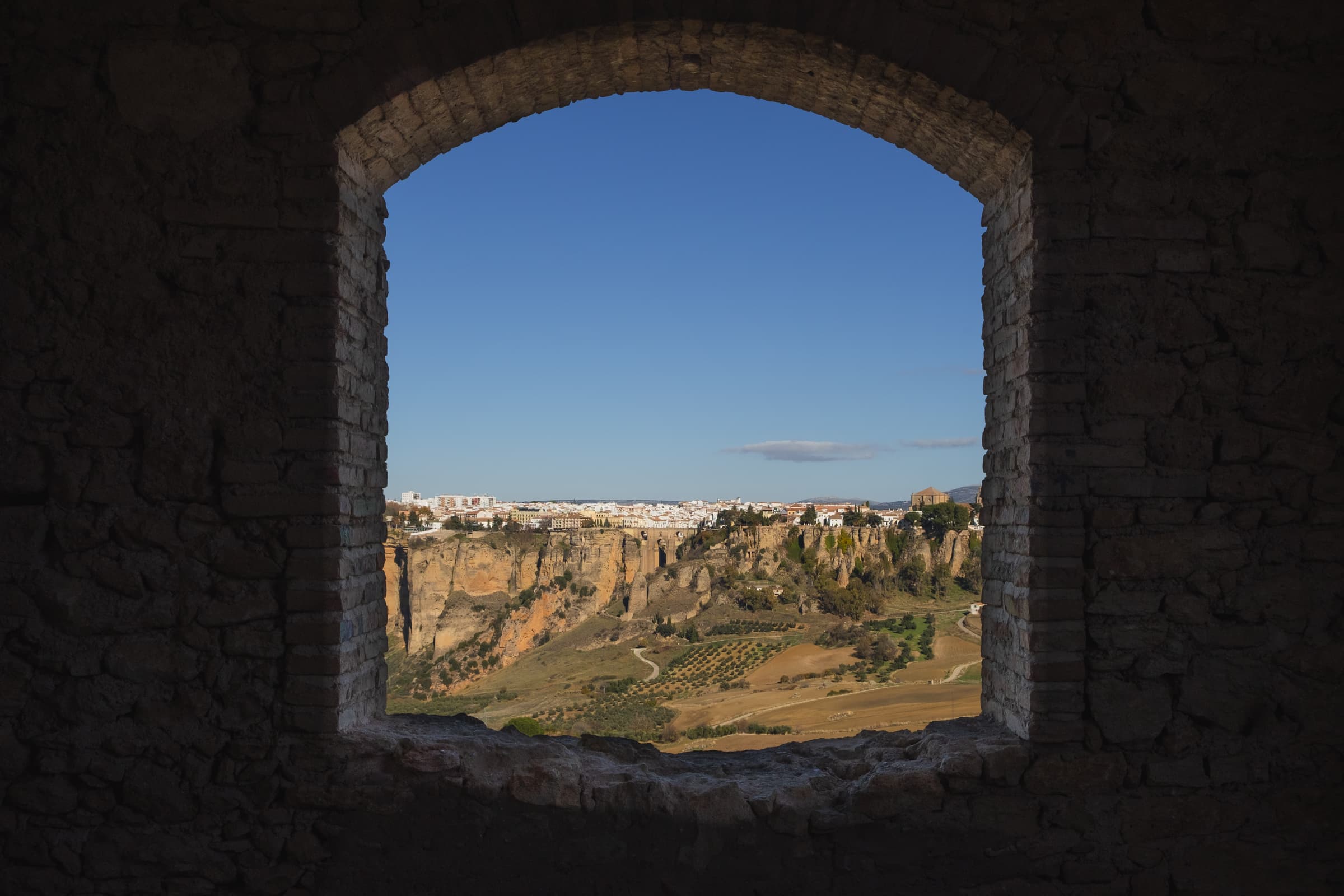
Remarkable Ronda. This magnificent town has been on our travel list for a long time now. We’re finally here, and it’s our final destination in Europe too. Two days to explore Ronda and then we’ll take a ferry to Morocco, my first time on the African continent. It’s going to be an action packed few days!
The train pulls into the platform at Ronda’s main station – It’s out of the way, but that’s to be expected, because the old town sits on a humongous rock and hangs on the edge of a cliff. It’s pitch black and we’re tired. We’ve been travelling all day. The trains are sparse in the destinations we are visiting. In El Chorro, where we’ve come from, trains only pass three times a day and there are long waiting times at connecting stations. We spent a few hours in the middle of nowhere at Bobadilla.
Hitchhiking is getting harder and harder the more south we get. Maybe we need a shower or maybe it’s just not as common here. We got a few rides in Portugal and a couple in southern Spain. We’ve had to take quite a few busses and trains recently, and it’s eating into our budget. However, it might also be due to the fact that we’re on a much tighter deadline now. We need to be back home for Christmas and it’s now the 2nd of December. We’ve got just over two and half weeks left. Much less time than we wanted to spend in Morocco, but well, we were having a blast. It was important for us to be flexible and change plans, that’s where the real adventure lies!
Navigating Ronda in the dark
Anyway, we’re in Ronda, it’s very dark. We just want to go to sleep. It’s a fifteen minute walk to our apartment and when we arrive there it’s quite strange. I suppose that’s on us for booking an Airbnb in an artists house. We enter through the front door of a terraced house. The layout of the house is like those on old industrial worker streets in the UK. It’s very surreal and not what we expected.
The host is nice and there is a cute dog wandering around. There are a few more rooms upstairs with other guests, but it’s just someones home. It’s not very big so we don’t really have much privacy, which I think from the owners perspective is a good thing. For us, me in particular, it’s a bit cramped and feels like we’re intruding in someones house. Most likely because I’m beginning to feel ill, probably from the bus of death in El Chorro.
We have a little chat with the owner and then head off to sleep. We need all the rest we can get to explore Ronda before we move on in two days time.
Tumultuous history in Ronda
If you’ve never heard anything about Ronda then you’re in for a treat. It’s magnificent. It’s awe-inspiring, It’s like a town straight out of Lord of the Rings. And I hate comparing towns to places in movies because most likely, it’s the town that inspired the movie, not the other way around. It’s a truly romantic place with one of the most impressive bridges connecting two sides of a plateau.
Ronda, much like Granada, was ruled by Christians and Muslims and its architecture reflects those intertwining of cultures. However, its history is not very peaceful, as you can probably imagine, albeit, very interesting.
There are Neolithic remains around Ronda: one of them the impressive cave paintings of Cueva de la Pileta. It was thought to be first settled by the Celts. However, the current Ronda, is of Roman origins. The city title was awarded during the reign of Julius Caesar.
In 713 Ronda fell to the Moors, who invaded from North Africa. We wrote about the Moors and the Iberian empires in our post about Granada – which shares much of the same history, so we won’t repeat it here.
After the caliphate of Córdoba fell, a small kingdom led by Banu Ifran flourished with Ronda as its capital. It was during this period that Ronda gained much of its Islamic architecture.
Christian Reconquista & Muslim persecution
Ronda’s Moorish rule came to an end during the Christian Reconquista. Much of the city’s buildings and institutions were adapted or replaced with Christian counterparts.
Next came the Spanish Inquisition, where consolidation of power in a new forcefully reunited Spain was initiated. The Inquisition affected Muslims and Jews terribly, many were imprisoned and horrifically burnt alive in front of crowds.
When Granada fell, the last stronghold of the Moorish rule in Iberia, the order was that all Muslims in Spain must leave the country immediately or convert to Christianity. Many converted in order to stay and keep their belongings, but of course, secretly practised their true religion in secret. Those Muslims who converted were named Moriscos.
Quite belittling, these converts were forced to wear a blue crescent on their caps and turbans in order for others to identify them, most likely to treat them as second rate citizens. They were not allowed to travel without a permit and if ignored, were sentenced to death. This oppression sought to drive Muslims away and seek refuge in the mountains of Sierra Nevadas. One of those places was Ronda.
Continuing with the erasure of Moorish culture, in 1566 the use of the Arabic language became illegal, doors to homes were to remain open on Friday to verify the absence of Friday prayers and unfair taxes were applied to Morisco trade.
This systematic suppression led to various uprisings, one in particular, in Ronda, led by Al-Fihrey. The rebels defeated the Spanish army sent by Alfonso de Aguilar. Ultimately, this defeat pushed the Spanish to order the expulsion of all Moriscos in Ronda.
In more recent history Ronda was greatly affected by the invasion of Napoleon and the Spanish Civil War.
More of Spain!
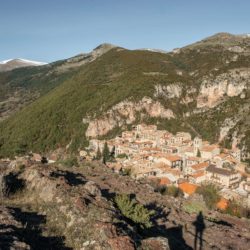
Wild and without enough time: Catalonia to Portugal
And so begins one of the longest journeys of our European hitchhiking travels. We have one more brief stop in Catalonia and then we need to get to Portugal, for we have lost a lot of time. Originally we had planned to hitchhike through northern Spain to Portugal and down to Porto. We have come […]
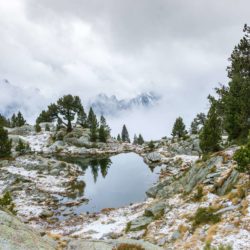
Wild and without: Aigüestortes i Estany of Saint Maurici National Park
In the heart of the Pyrenees, we wake up from a cosy nights sleep in our tent, it was cold but not excruciatingly so. Wide awake, freshened and energetic to explore. We came to Espot to experience the mighty Pyrenees mountains. We decided randomly on the national park Aigüestortes i Estany of Saint Maurici. Well […]
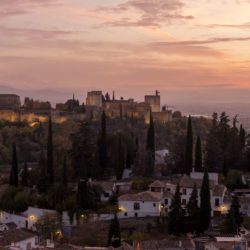
Wild and without borders: Where cultures fuse in Granada
It’s 2AM and we’re waiting for the bus to Granada. Today was our last day in Portugal. For the last few hours we’ve been hanging out in the hostel common room, preparing sandwiches for our journey and generally abusing our stay. We only paid for one night, and we were supposed to check out at […]
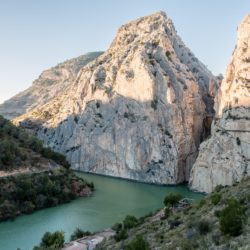
El Caminito Del Rey: The once most dangerous hike in the world
It’s been a while since we managed to hitch a ride and today’s not going to be our day. The plan is to hitch from Granada to El Chorro and then tomorrow we can hike in the infamous El Caminito Del Rey canyon. Before swiftly moving on to Ronda, our final destination in Europe! The […]
No time to be ill
I wake up late and groggy from the previous days woes, I’m full of cold, with a headache to boot. That damn contagious bus from El Chorro. Everything is going slower but I’m determined to get out and explore. We simply don’t have the time to rest. So out we go, on to the sleepy streets of Ronda.
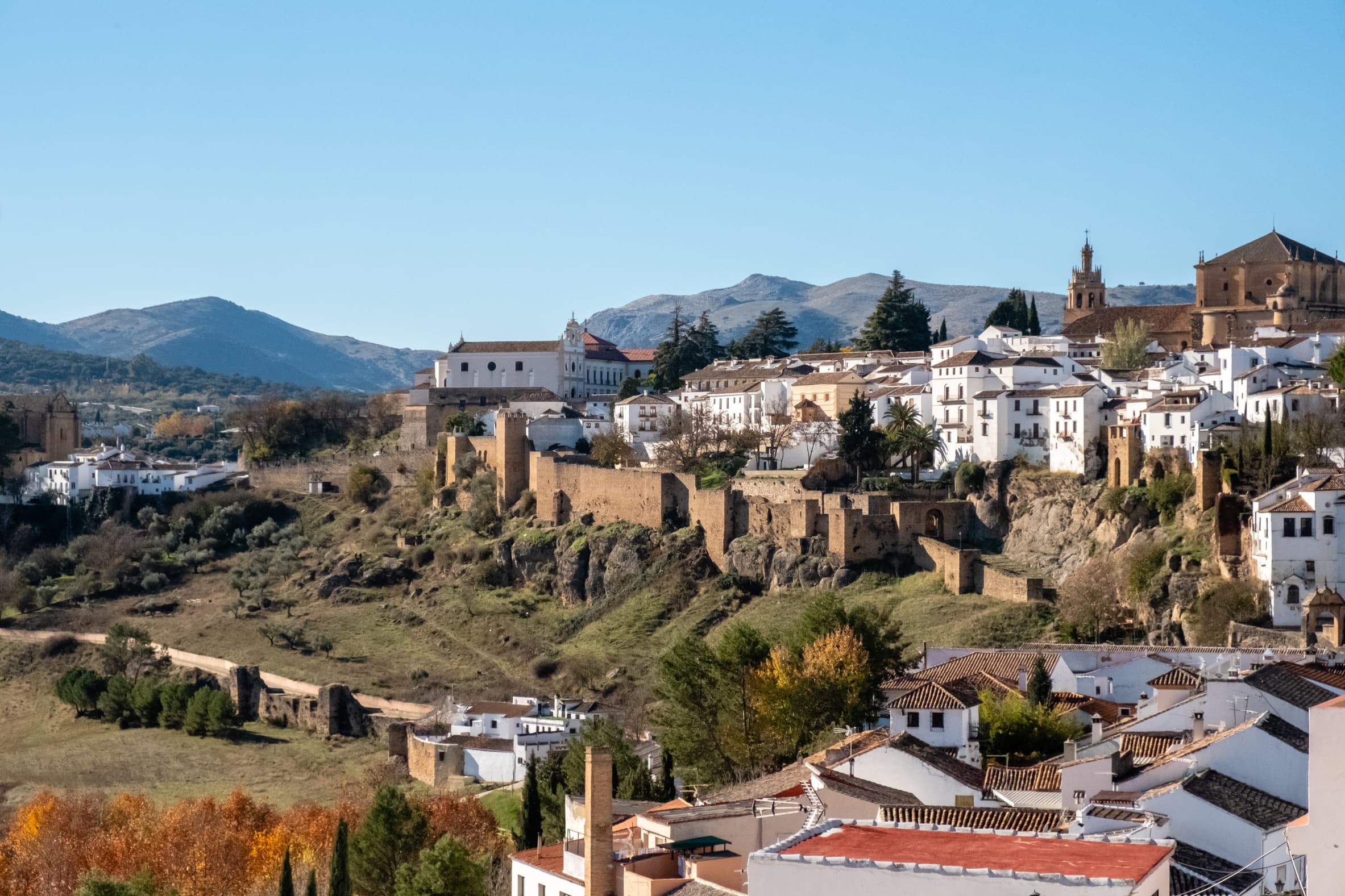
The neighbourhood we’re stopping in is just out of the centre, but that’s nice, because it allows us to explore cobbled streets and walk along the cliff sides of the old town. We’re up and down, winding through old streets and pretty buildings and before long we find ourselves looking over the castle walls and one of the famous old bridges of Ronda.
If you know of Ronda, that’s probably what enticed you to visit, the magnificent bridges, but more on those later. We plan on finding a vantage point where we can see the famed Ronda in all its glory.
Abandoned villas and views on Ronda
We cross over Puerto Viejo (The old bridge) and head into the Arab quarter. We wander around, climb some towers, enjoy the views and head straight out of the city. Next, we walk up the road C. Torrejones, heading for a building we saw in the distance. This is a residential area and there are no more tourists around.
At the edge of town we start the SLA-36 trail. It’s a 4.2 kilometre trail which finishes at the Cave shrine of the Virgen de la Cabeza. However, along the way, we get sidetracked by the fascinating decrepit Villa Apolo. Unfortunately there is a fence surrounding the perimeter with a strictly no-entry warning sign. The whole site is in complete disrepair, no one is living there and no-one is around. It’s a shame for this to be off limits for no reason. We’re not going to cause any damage so we sneak around the side and sure enough the fence is wide open there.
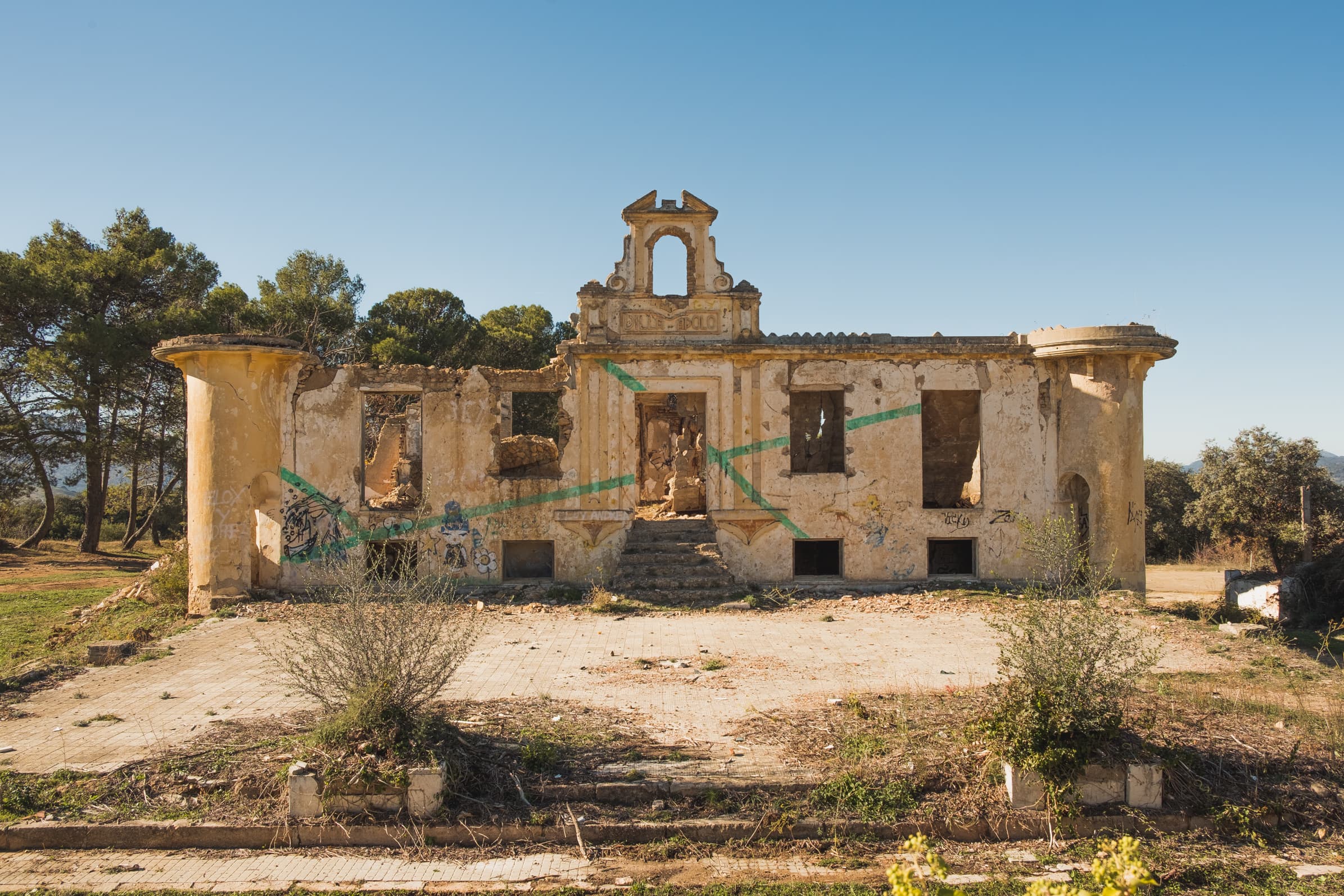
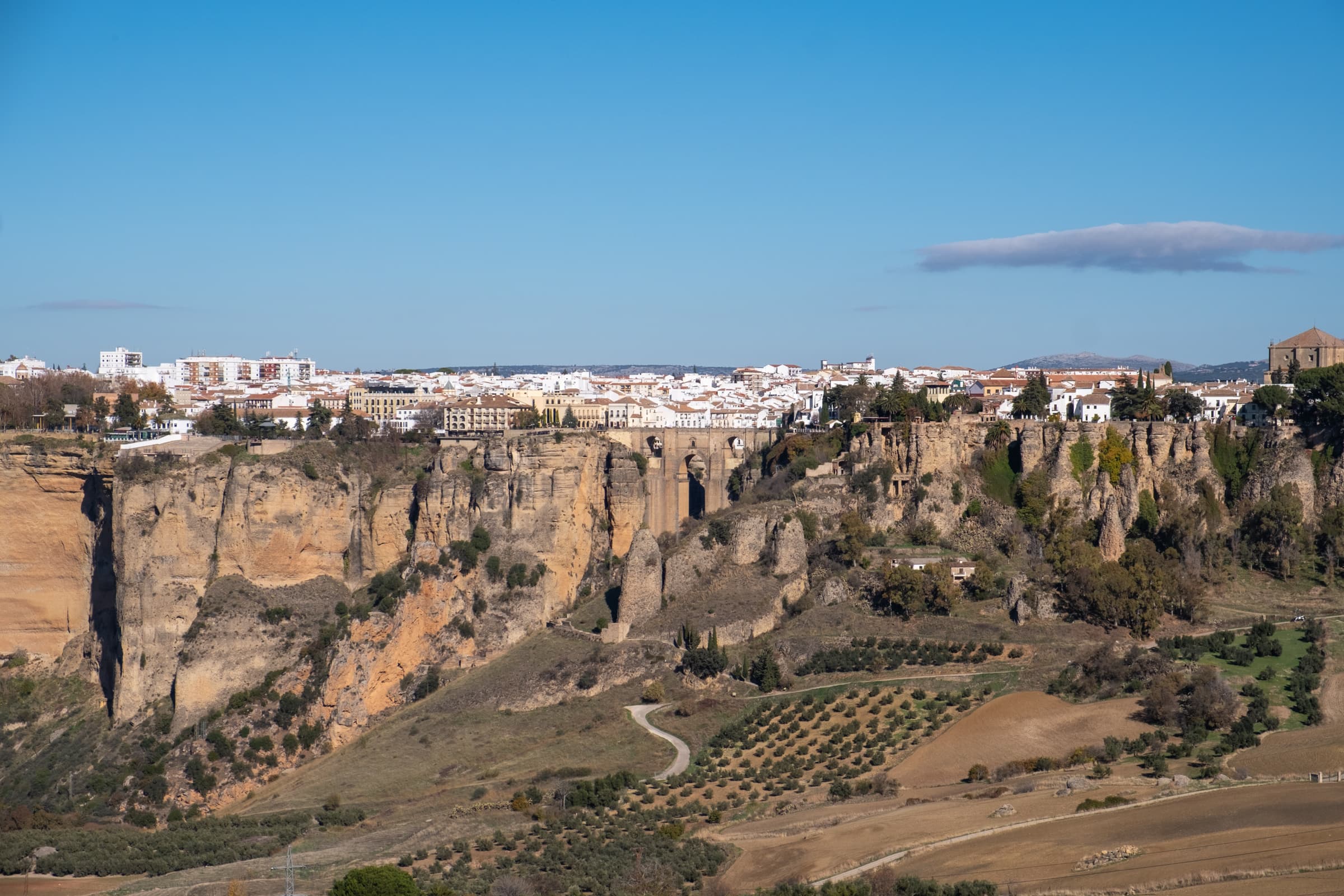
The villa is in tatters. It once must have been a luxury residence, for no doubt a noble family. With sweeping panoramic views of Ronda and the Sierra Nevada mountains, those living in this magnificent home lived in the perfect location. Not any more, the floors are trashed, exposing the foundations below. The roof has collapsed and some of walls have crumbled away.
Just around the corner is a two story tower which appears to be in rather good condition. We are happy to find the entrance unobstructed with a stair case leading to the first floor where a huge brick window perfectly frames the city of Ronda.
The three bridges of Ronda
Ronda is perched on the cliffside of a divided plateau. A steep gorge carves through the middle of town, the river Guadalevín flowing between. The Tajo gorge is 68 metres at its widest point, and up to 120 metres deep. The gorge splits Ronda in two, with three bridges connecting the halves:
- New bridge, Puente Nuevo
- Old bridge, Puente Viejo
- Roman bridge, Puente Romano – Sometimes known as the Arab bridge
The Roman bridge, the oldest of the three, was actually built by the Moors and not the Romans. Most likely built after 713 during the Moorish reign. It is a small bridge leading to the old San Miguel quarter, by the old Arab baths.
The old bridge was built because the Roman bridge became too small and so was replaced with this bigger construction which is wide enough for carts and cars to travel on.
The new bridge, which is not really that new, was built in 1793. It’s now one of Spain’s most photographed locations, and it’s not without its own history!
Puente Nuevo – The pearl of Ronda
The new bridge, which was planned to traverse the 120 metre gap between the gorge walls, was started in 1735. The bridge was designed and built by the architects Jose Garcia and Juan Camacho. Unfortunately the structure was not adequate in strength and design. It fatally collapsed, killing 50 people in 1741.
In 1759 the bridge was redesigned by José Martin de Aldehuela and rebuilt with Juan Antonio Díaz Machuca as the principle builder. It took 34 years to finish. Included in the structure is a room above the central arch that has been used as both a prison and a torture chamber. The chamber now houses a small museum depicting the bridges history.

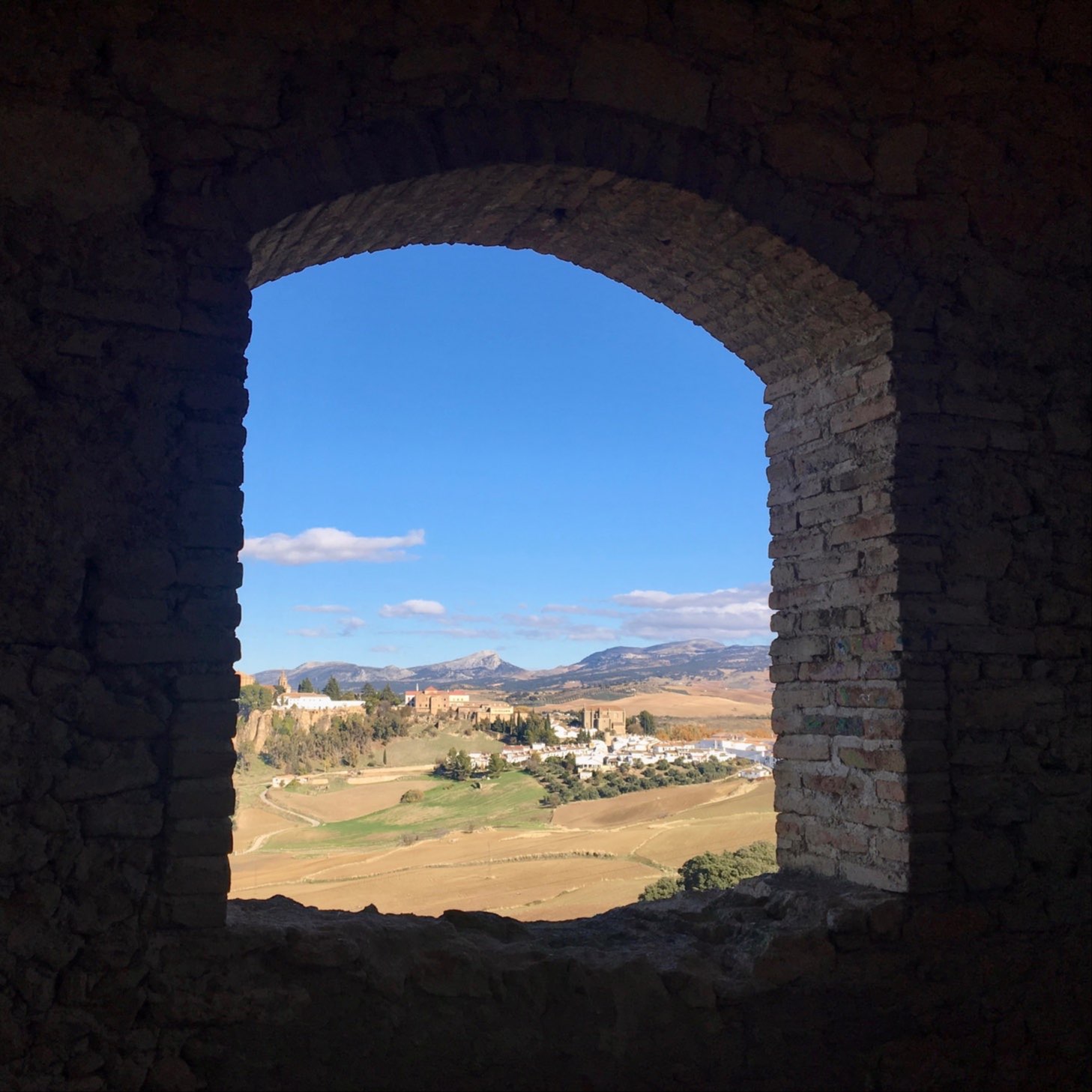
About time to get lost
After admiring the view we decide it’s time to get up close. See that road winding up to the bottom of the bridge? That’s where we’re heading. We look on maps.me and it appears we can follow some trails through the valley, without having to take a detour, so off we go.
If you’ve been reading our blog for any amount of time you will realise that problems and disasters are always looming. We head down the trail and before long it just stops. We can’t be bothered to turn around so we just keep walking through the fields. Shortly after we’re bushwhacking head high crops, completely lost. Fences surround all of the fields. We climb one and then hear a dog barking. It sounds nasty and we start to panic. We continue along a path heading for a road that looks like it’s not that far away from the map.
Next we pass an old farm that looks like someone lives there, the door is wide open, but no sign of any humans. We spot the dog tied up and then he spots us. It’s clearly on a leash, but barking like crazy. I’m trying to reassure Caroline that he can’t attack us while simultaneously coming to terms with the fact that we might soon be eaten alive.
We’ve got one more field to cross, and then we spot the farmer. We shrug at him and tell him we’re lost, of course he doesn’t understand. Caroline points across the field and gives a thumbs up sign, he reciprocates and returns a thumbs up. We cross the field and breathe a breath of fresh air as we arrive back in safety.
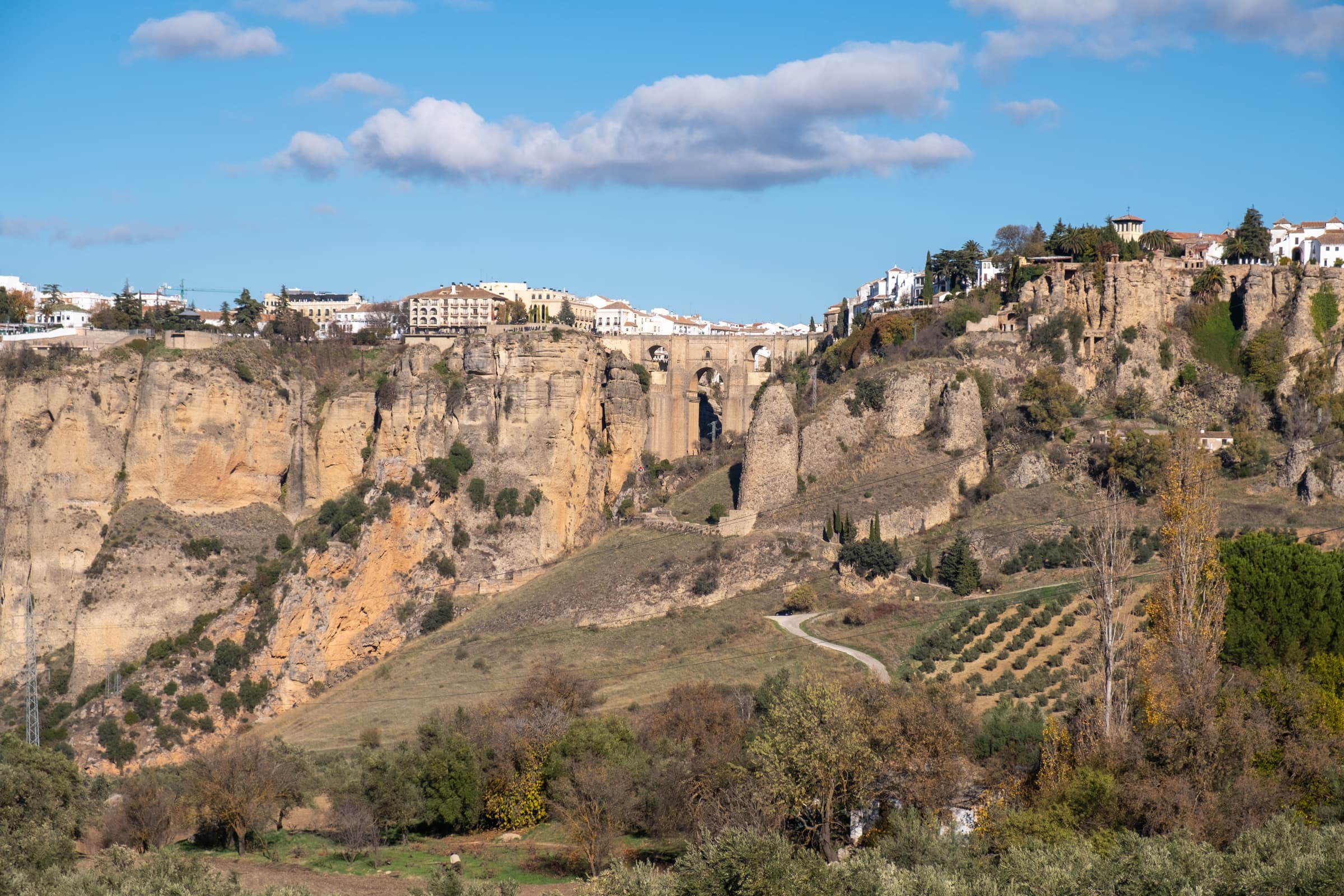
Exploring the 120M deep Tajo Gorge
As we approach the new bridge, the views become even more impressive. The sheer scale of the bridge is only realised when standing before it. It’s so huge it’s easy to strain your neck gazing up at the marvellous structure. However, there is more to discover than the bridge itself.
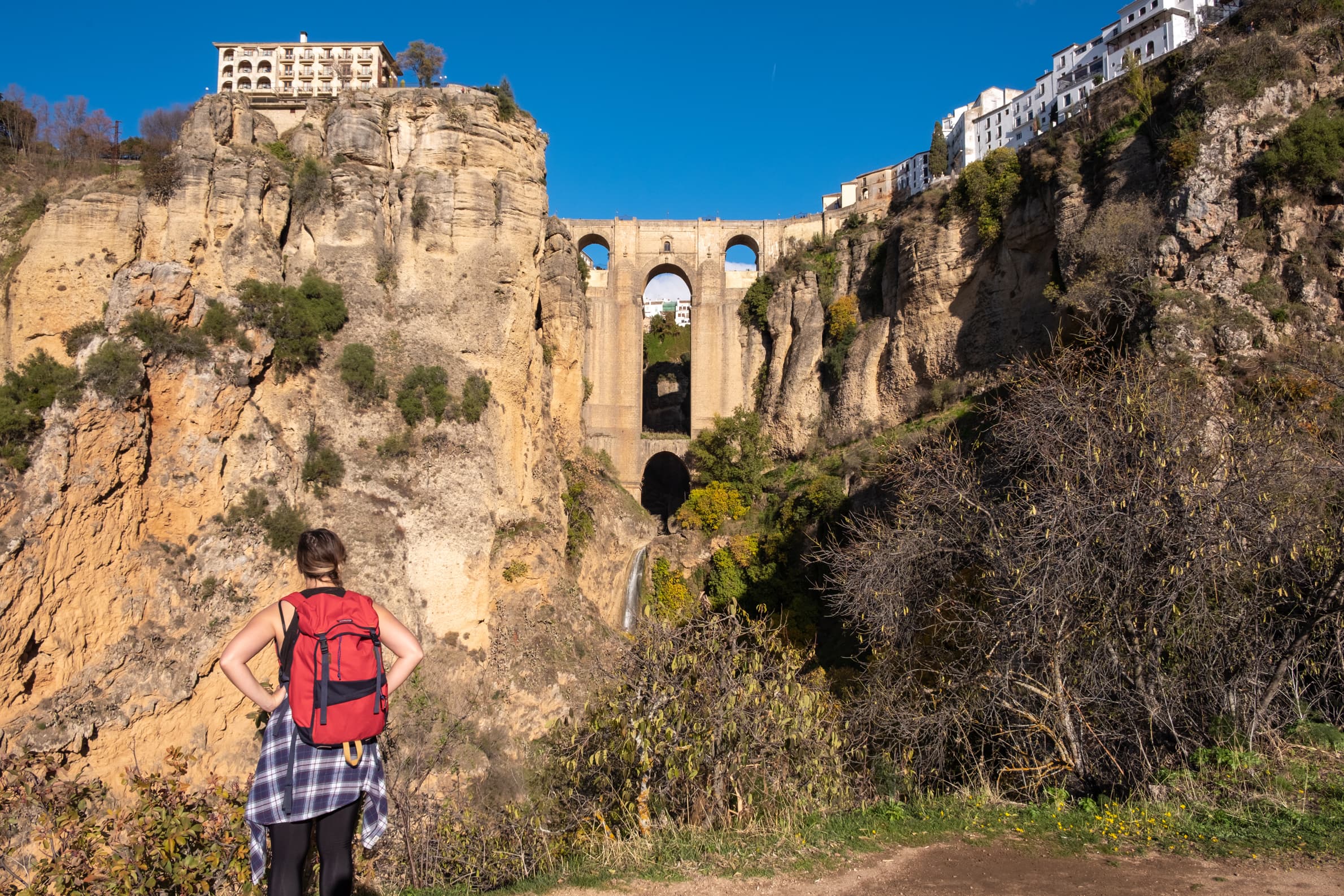
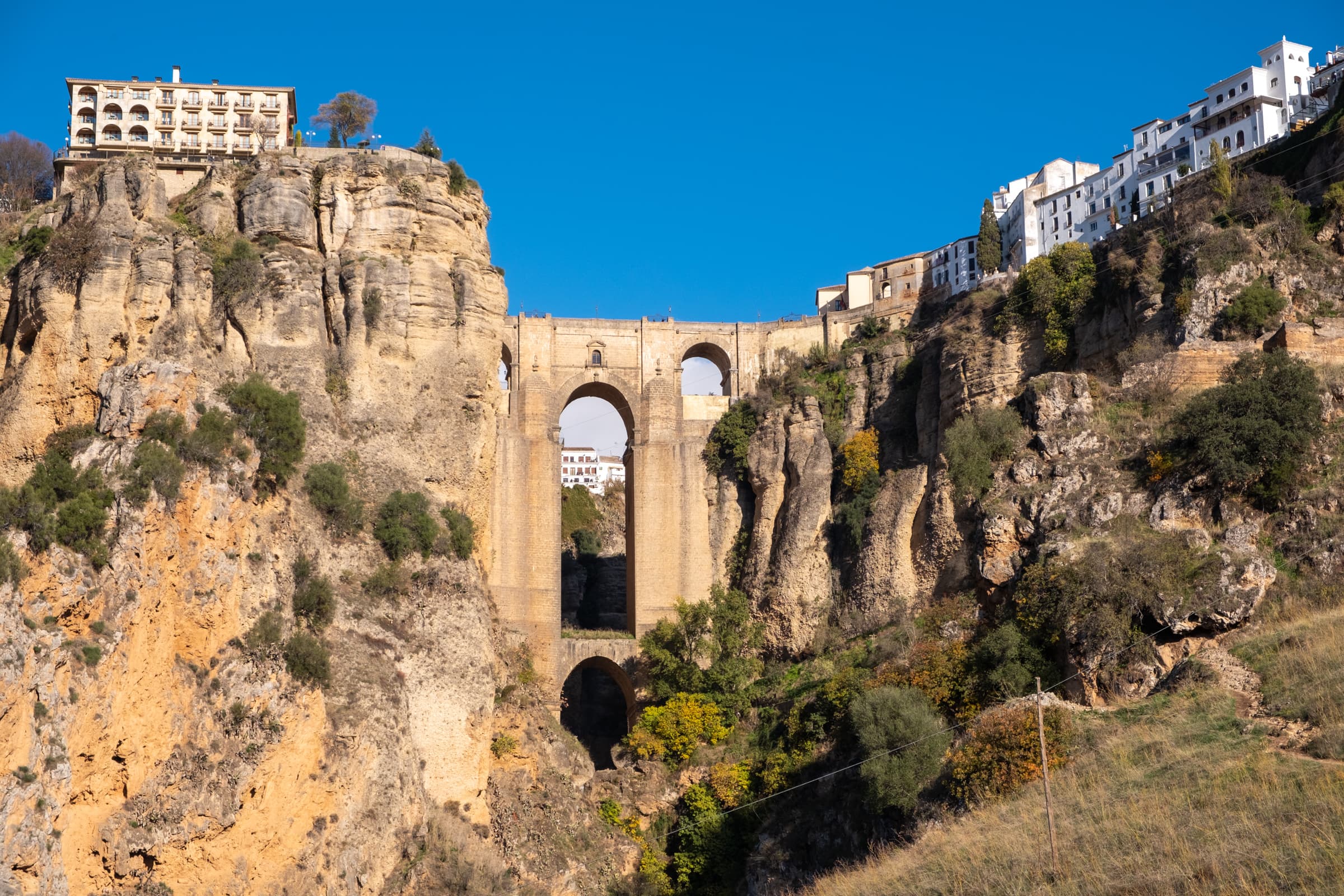
The river Guadalevín exits the Tajo gorge into the valley below where it used to drive a number of flour mills. All of the mills were rendered useless when in 1917 a rock slide destroyed the canal supplying the water. Nonetheless, there are many remains of the intricate system left around the valley. It makes for fascinating exploring, since nothing is discouraged and some of it is quite precarious.
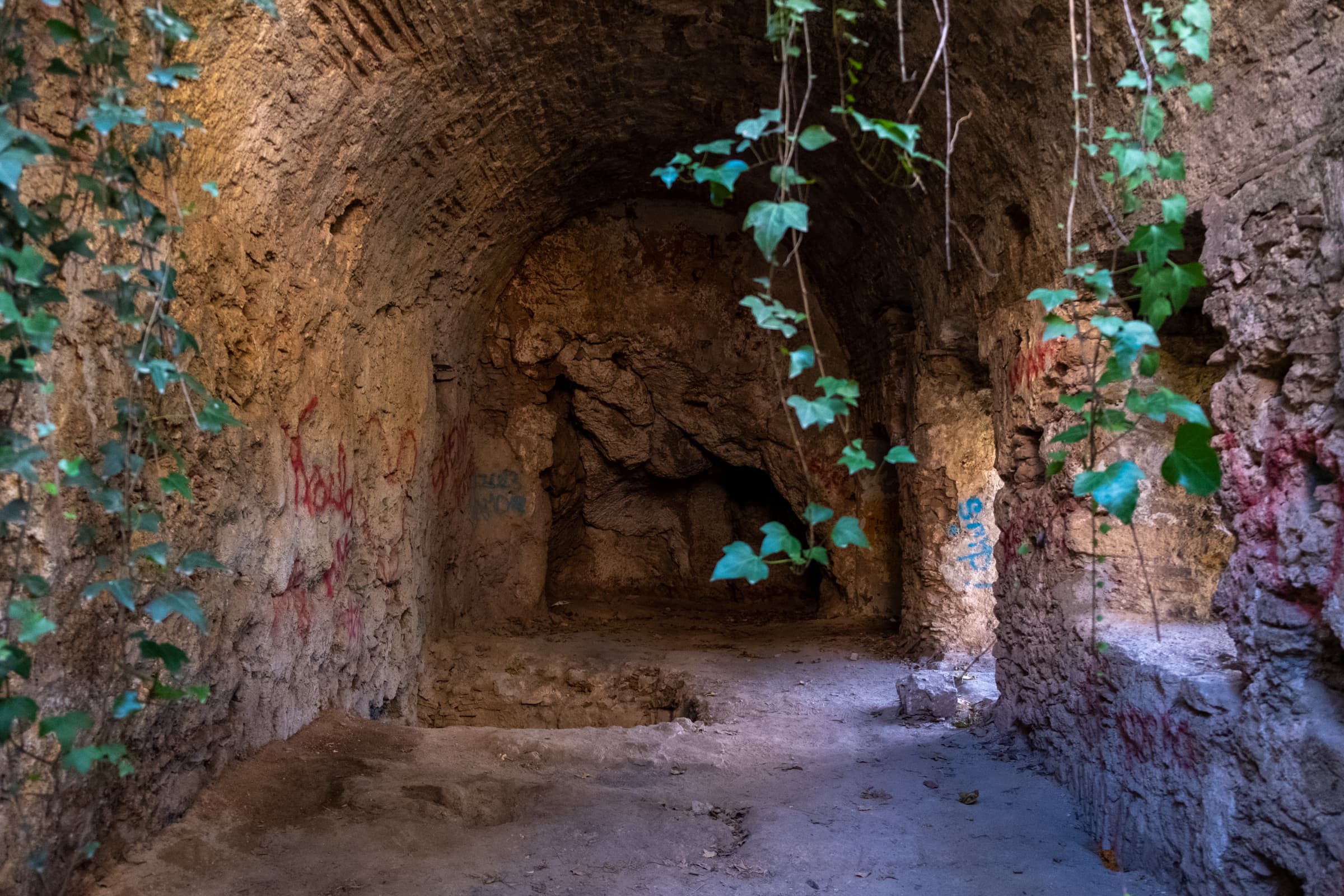
Behind the waterfall
We try to get closer to the waterfall and pass ruins and old archways. It must have been an important area in days gone by. The structures appear to date back to the Moorish times. We follow the water channels along a pathway with a steep drop on the left, and before long we are directly under the bridge, near to the waterfall. A precarious metal structure without a barrier takes us inside the arch of the bridge and into the other side.
It’s quite busy in the gorge, which is strange since just a minute ago it felt like we had the whole thing to ourselves. The water is deep and still. It’s quite eerie in here. Across the other side of the gorge, just past a small medieval dam wall is a building built in the rock face. A door leads to a metal balcony over the river and small defensive windows are carved into the gorge wall. It appears as though you can access the gorge from above! More on that later.
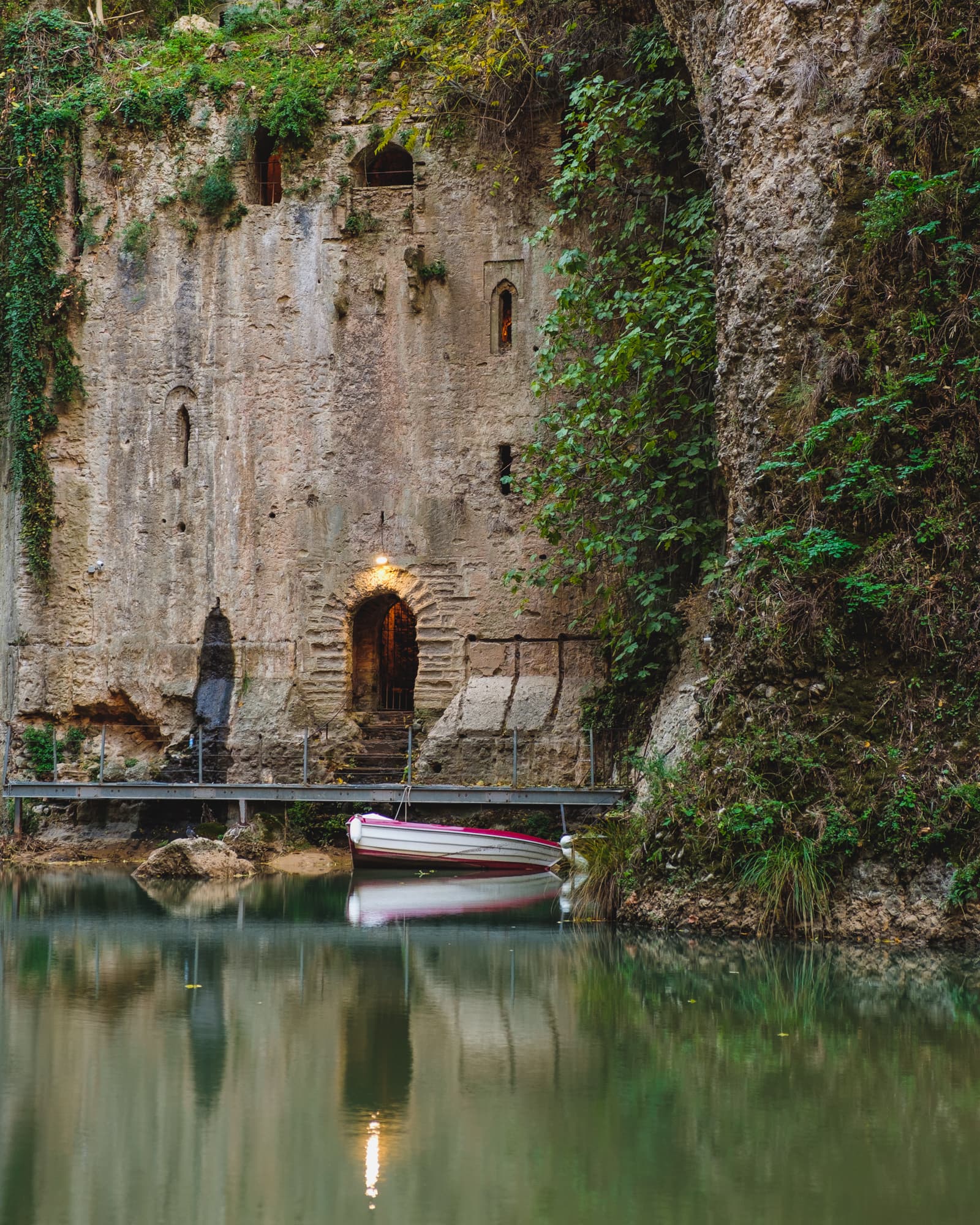
For now, it’s time to head back up to Ronda and get some food, and then a beer to watch the sunset with. What do you think? Sounds like a great idea to us!
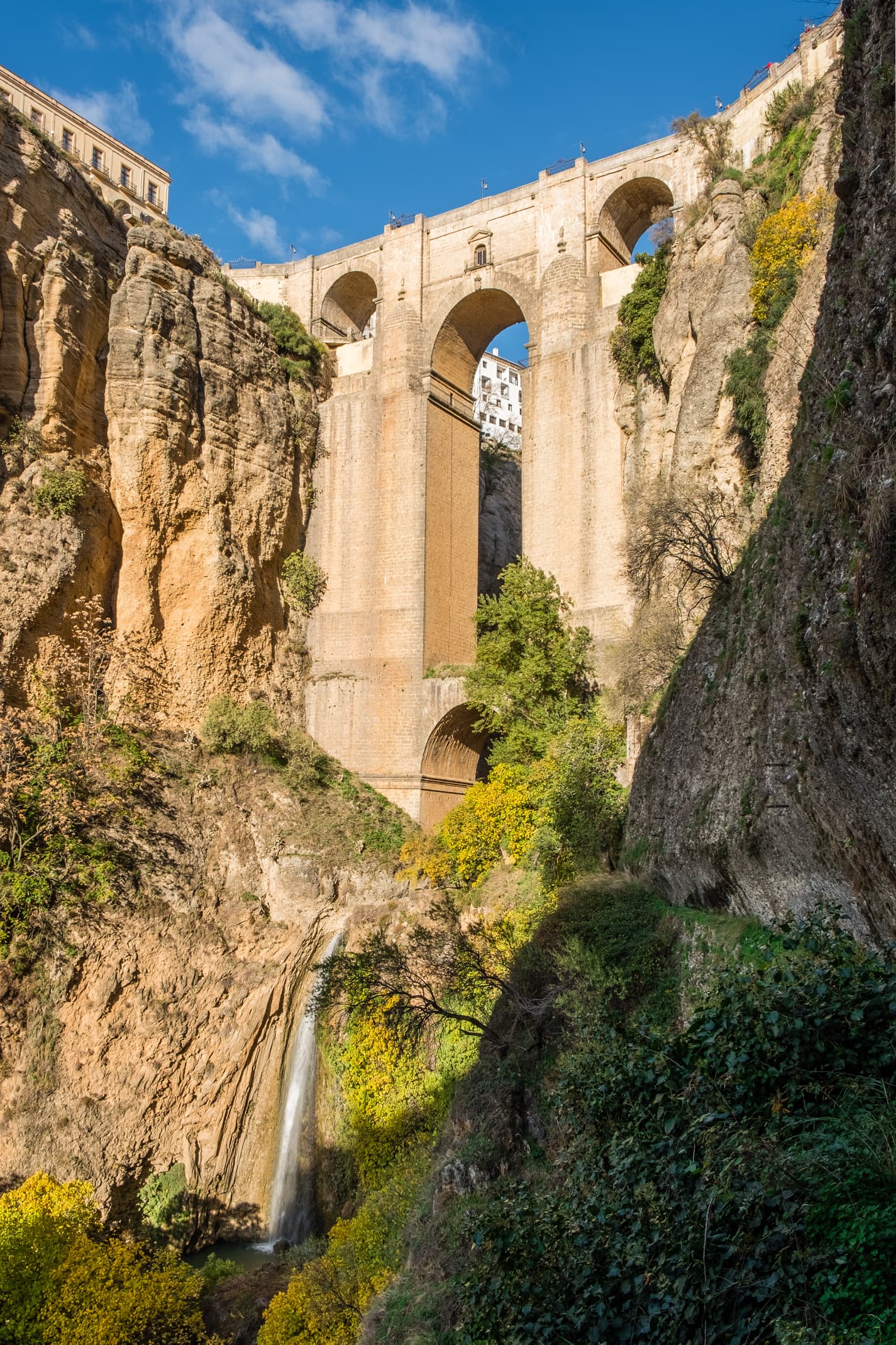
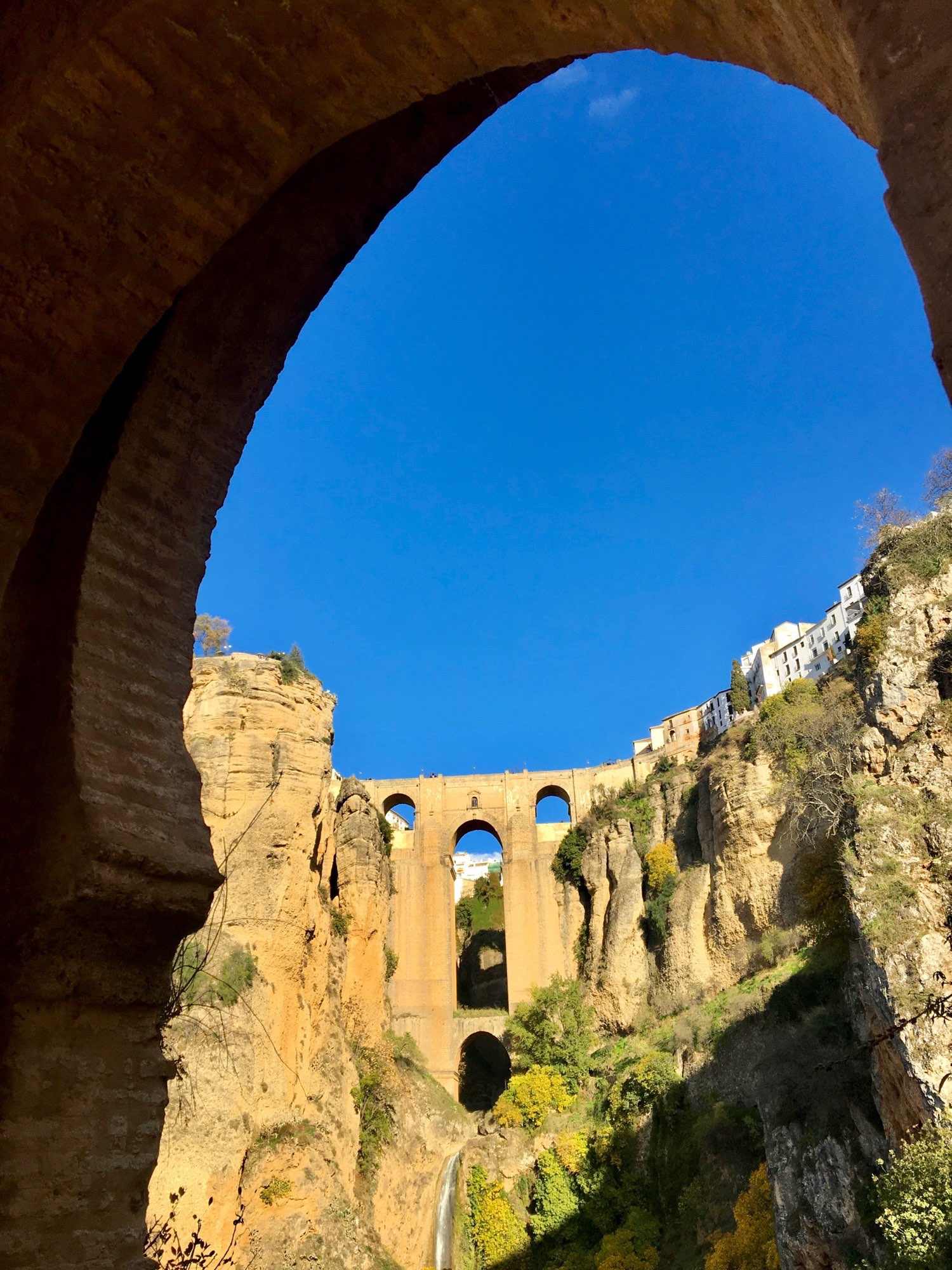
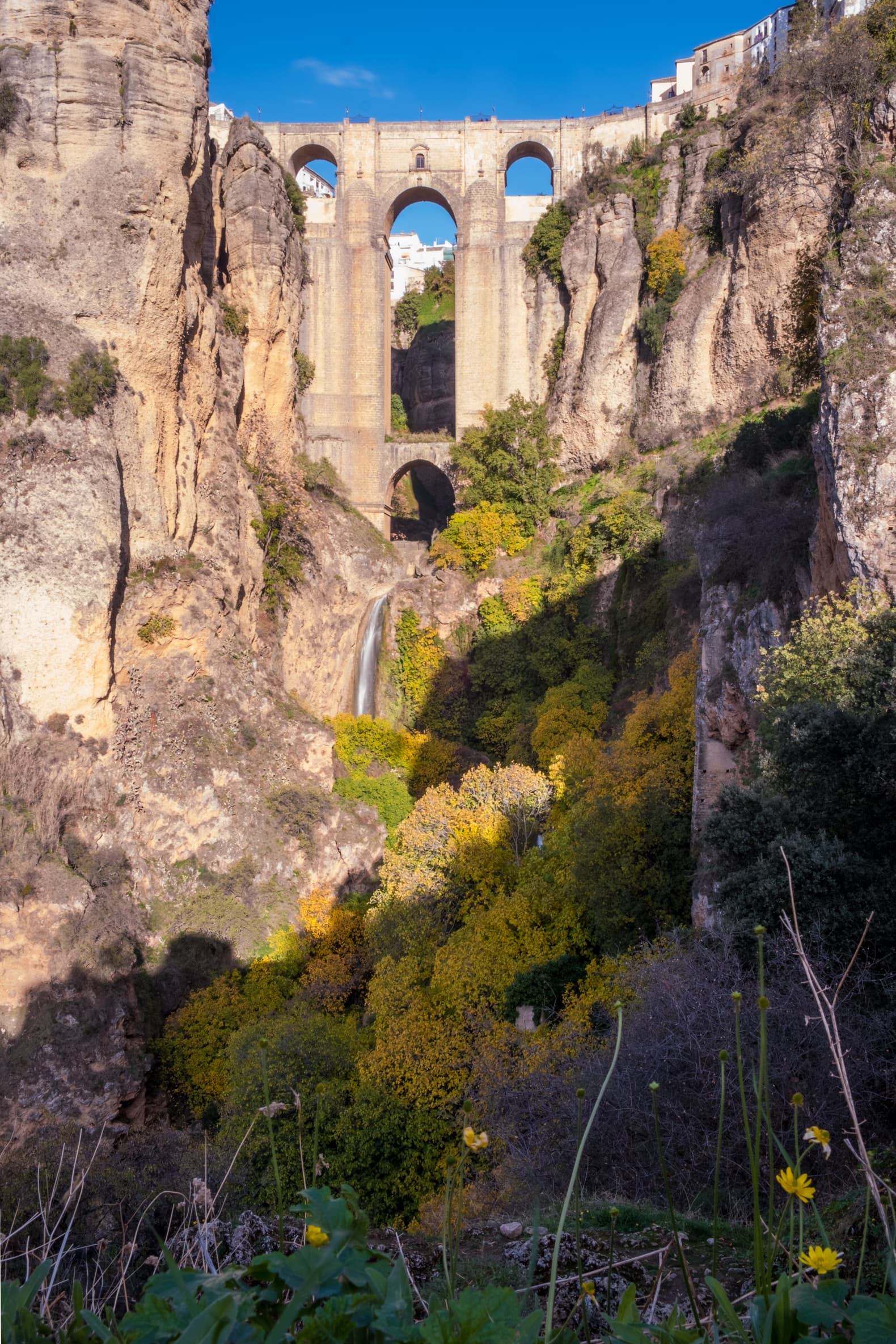
Sunset paradise in Ronda
One of the best things about Ronda is that it’s so well pedestrianised. You can walk along much of the cliff edge. You can sit and admire the views on one of the many viewing points (miradors), quite often large cobbled areas where many people congregate. There will be musicians, dancing, drinks and just a general great vibe. Even in the middle of winter, as it is now. If you are visiting in the winter, do wrap up though. As soon as the sun sets it becomes cold at an almighty speed, even when the sun is shining throughout the day.
Here’s a list of some of the nicer miradors:
- Mirador de Ronda – One of the most popular points with a pavilion and an outdoor theatre.
- Mirador de María Auxiliadora – A lovely shaded viewing area – It’s also where the path descends to access the El Tajo canyon and bridge viewing points, namely Mirador Puente Nuevo de Ronda.
- Mondragon Palace – A small museum depicting the history of Ronda with nice Islamic architecture and a wonderful little landscaped garden with fountains and great views.
- Alameda del Tajo – A park from the 1800’s with lots of trees, shade and a huge viewing platform.
- Mirador Virgen Del Rocío – A small platform a little way out of the centre with a monument to the Virgin of Rocío.
We grab a beer and take a seat at Mirador de Ronda, it’s not very busy, probably because it’s winter. We imagine it will be much more bustling in the summer. Brilliant yellow and orange hues light up the sky and a lady plays traditional folk music on an acoustic guitar. Couples lean against the railings watching the sun dip down below the Sierra Nevada mountains. Another couple lean on the railings, looking inwards, smoking cigarettes, appearing completely unimpressed.
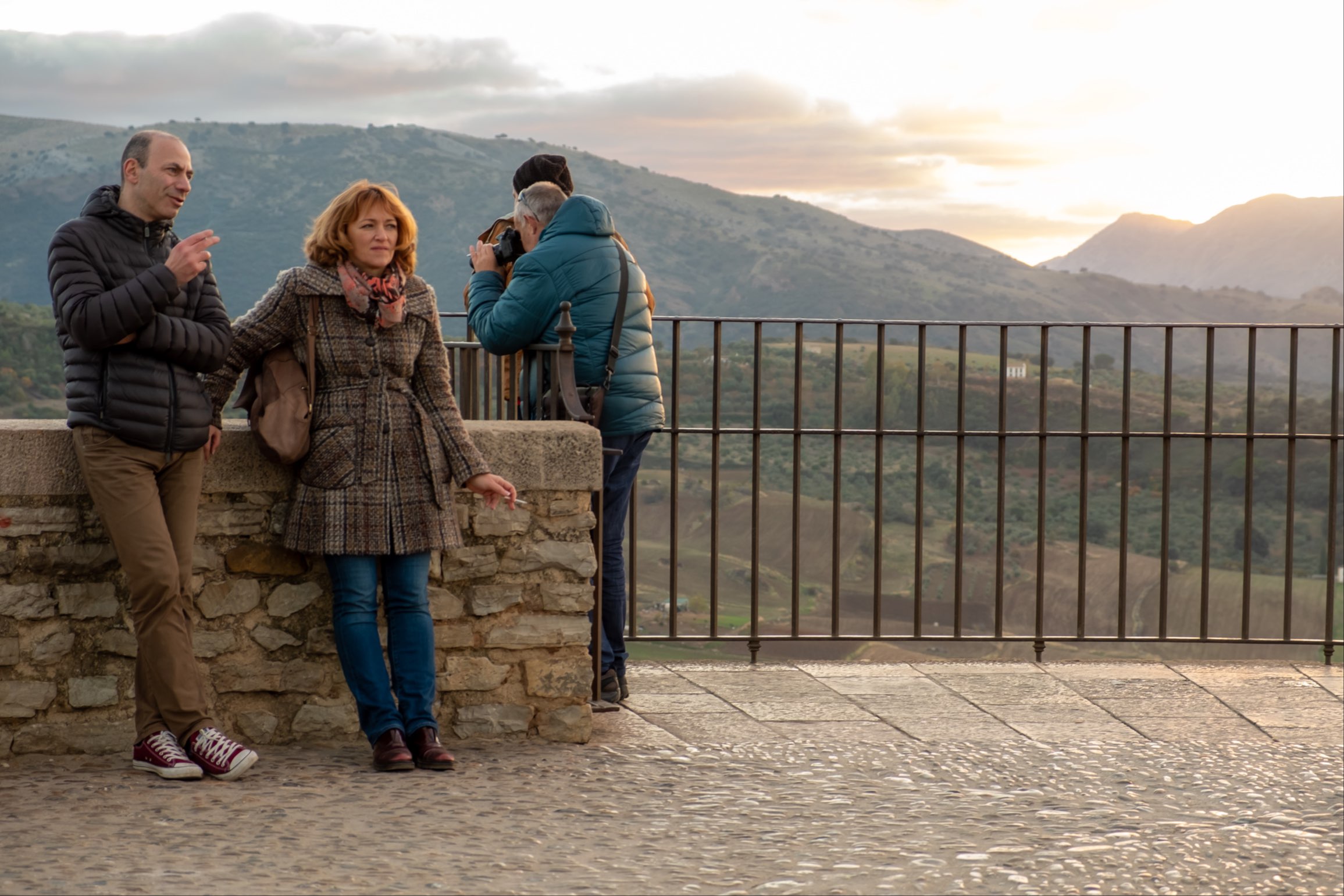
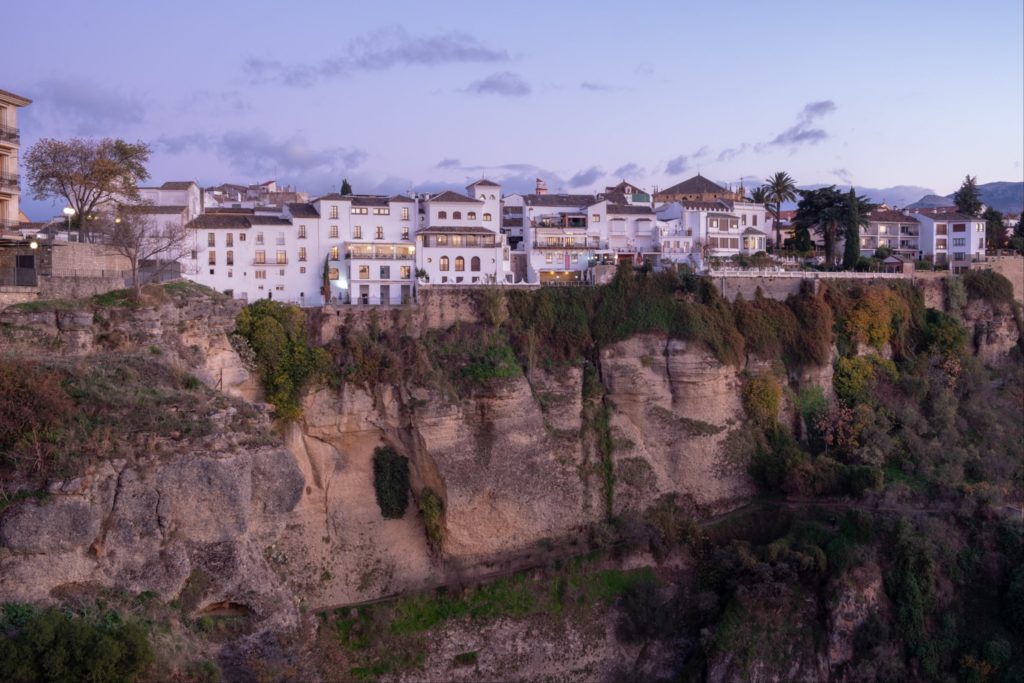
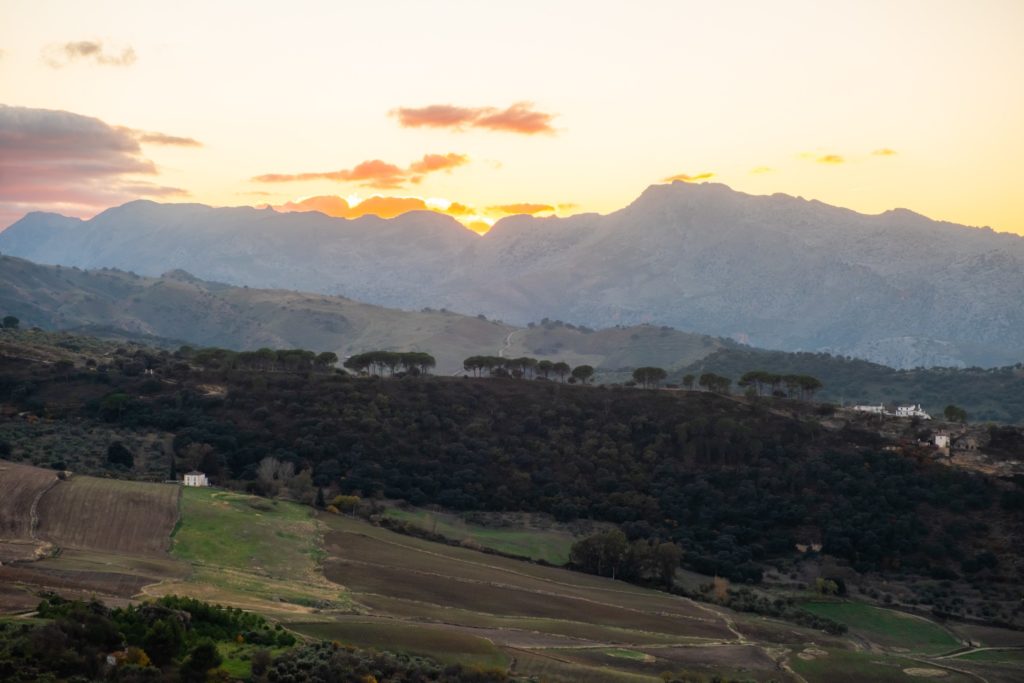
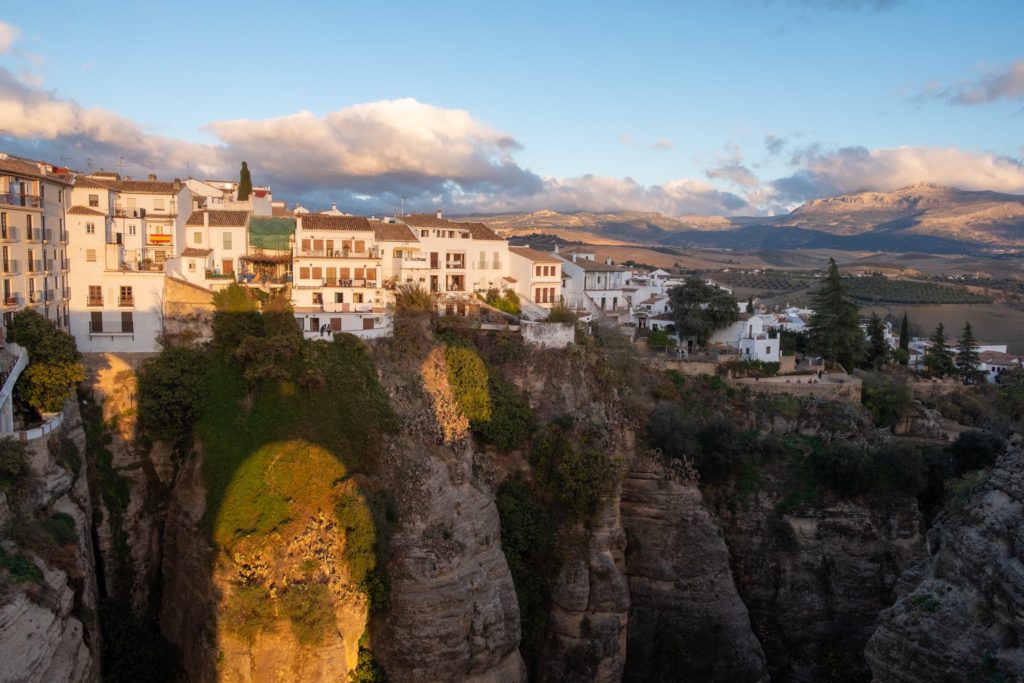
More charming European towns
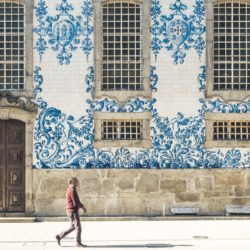
Essential Porto: Top 10 authentic things to do
Porto, what a city! We don’t usually write these types of posts, for us it’s mostly about the journey rather than the destination. Especially when it comes to hitchhiking, driving and camping in foreign countries. Most of our stories come from the detours, disasters and downright crazy situations we always seem to end up in. […]
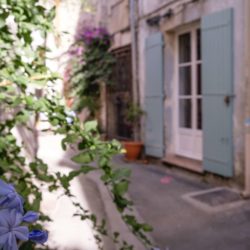
Wild and without an art education: Arles & van Gogh
Not exactly unhappy to leave the campsite in Manosque, we get up considerably early (for us anyway) and make our way to town to get a ride from there. Today we finally want to get to the seaside! (with a quick stop in Arles). I’m dreaming about sandy beaches and wild horses in the Camargue. […]
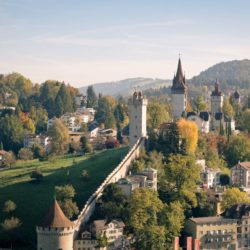
Wild and without worries in Lucerne
Lucerne is our end destination after a day of epic hitch-hiking-road-tripping through Switzerland. We’re exhausted, hungry and tired but also immensely grateful for the experience and soon doze off. Feeling refreshed the next morning, we get ourselves ready for a day in Lucerne. This takes a while. After all, we’re in a city now and […]
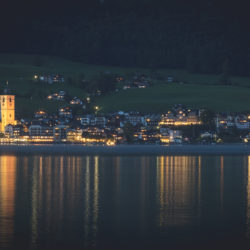
Wild and without a ticket: Wolfgangsee & Schafbergbahn
We’re on the road to Salzburg area – it’s only our third time hitchhiking and we’re apprehensive – the last time didn’t go so well. We want to get to a campsite on Wolfgangsee, a beautiful lake in the Salzkammergut region of Austria. There are two ramps on to the Autobahn in Schladming and we’re not sure […]
As the colours fade and the mood winds down, it begins to get cold. There’s only a few people left and we decide to make a move. It’s cold and we’re hungry. Caroline’s tired so we walk back to near our apartment and grab a few tapas bites in a nearby local restaurant.
After delivering Caroline back to our apartment I decide to go for one last little adventure and head back down to one of the viewing locations of the new bridge, I want to try and photograph it at night. It’s wonderful when lit up. It’s a big of a slog and I’m already knackered from all the walking today, but I’m determined. It gets more complicated walking down the precarious trails as there’s not much light as soon as I descend the cliff side. The whole escapade is fun, but the results are less than optimal. Worth showing nonetheless. Maybe I can inspire you to take better photographs!
Back in 2017 – I was not as handy with my camera and I didn’t have a proper tripod, just a tiny Gorilla Pod.
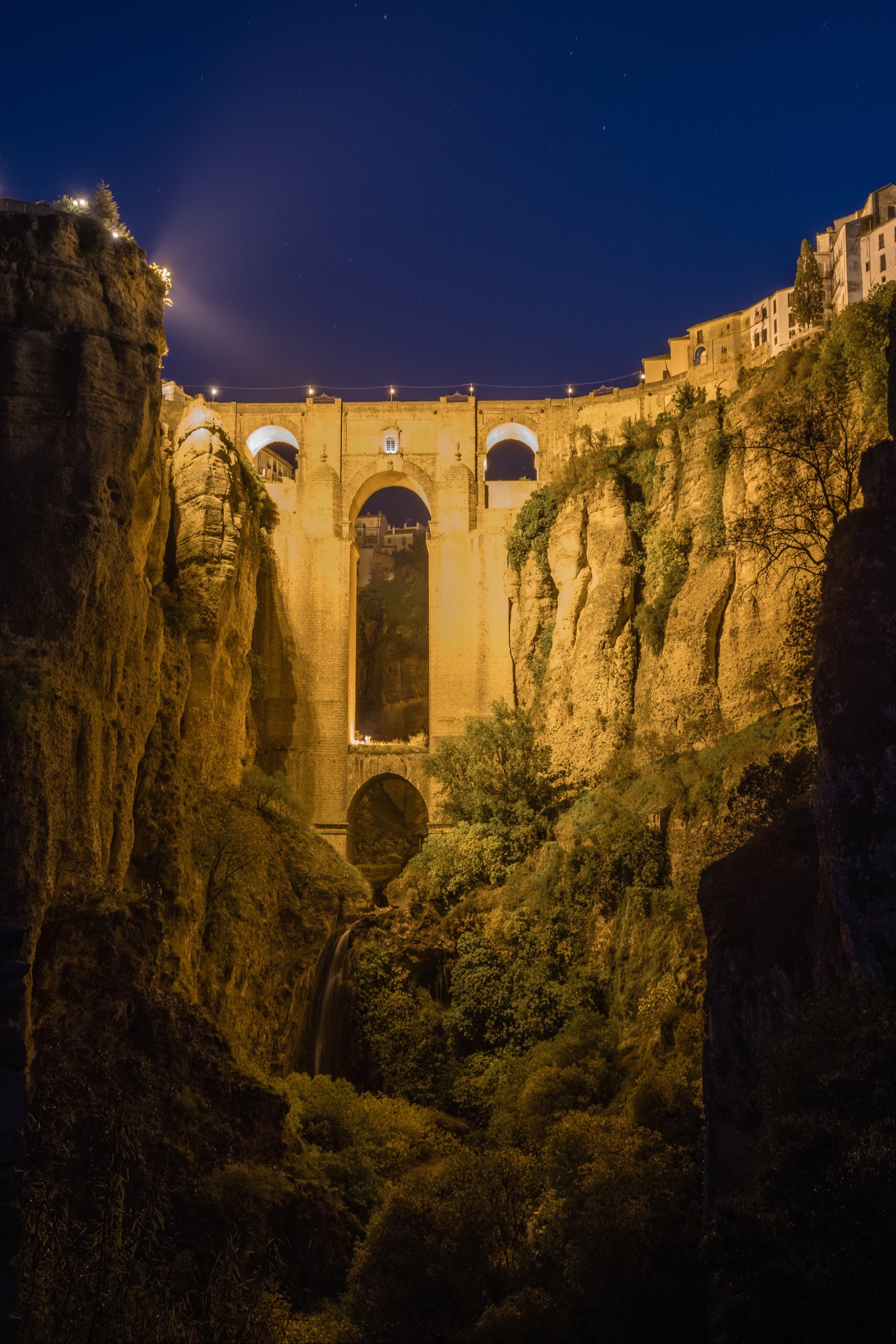
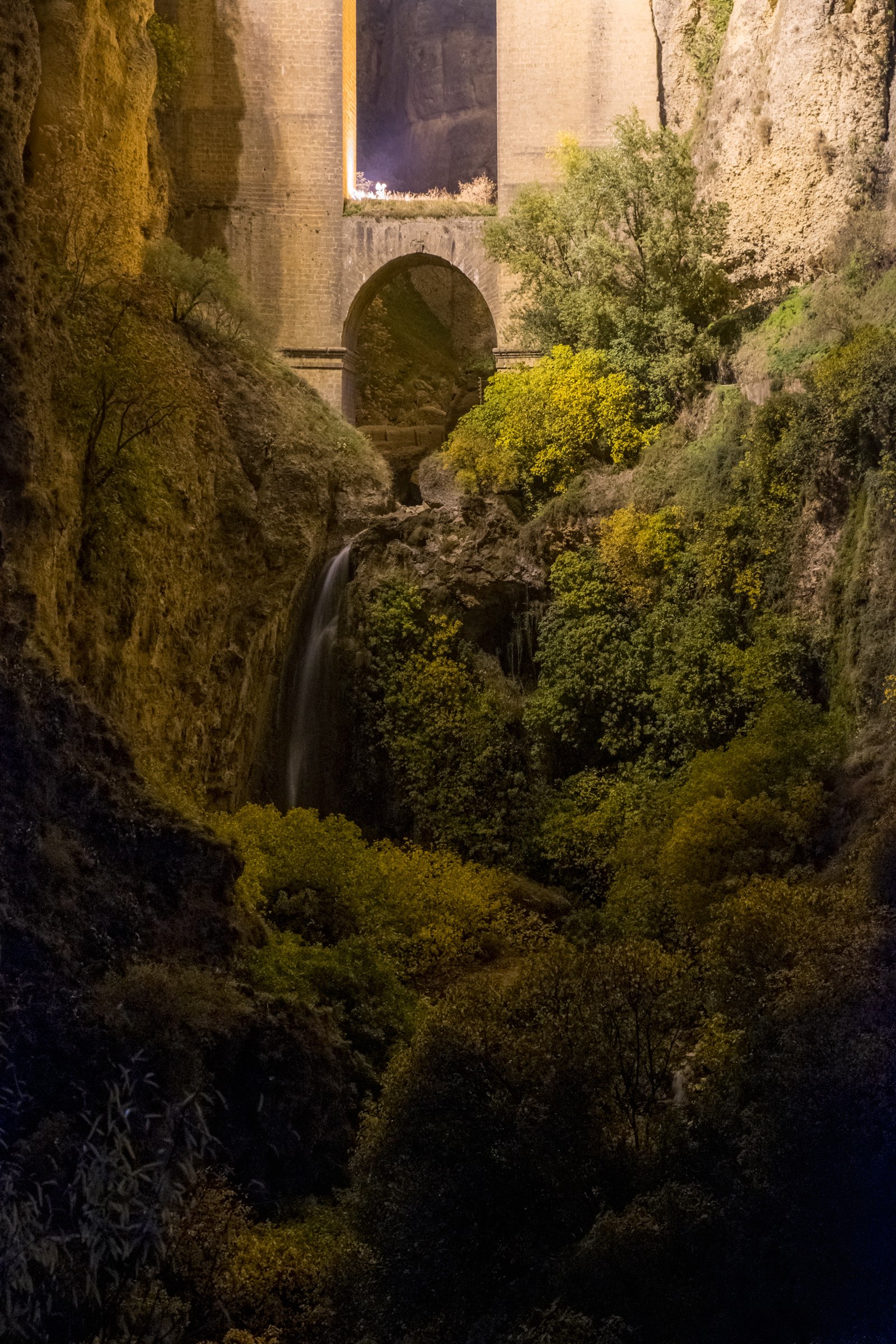
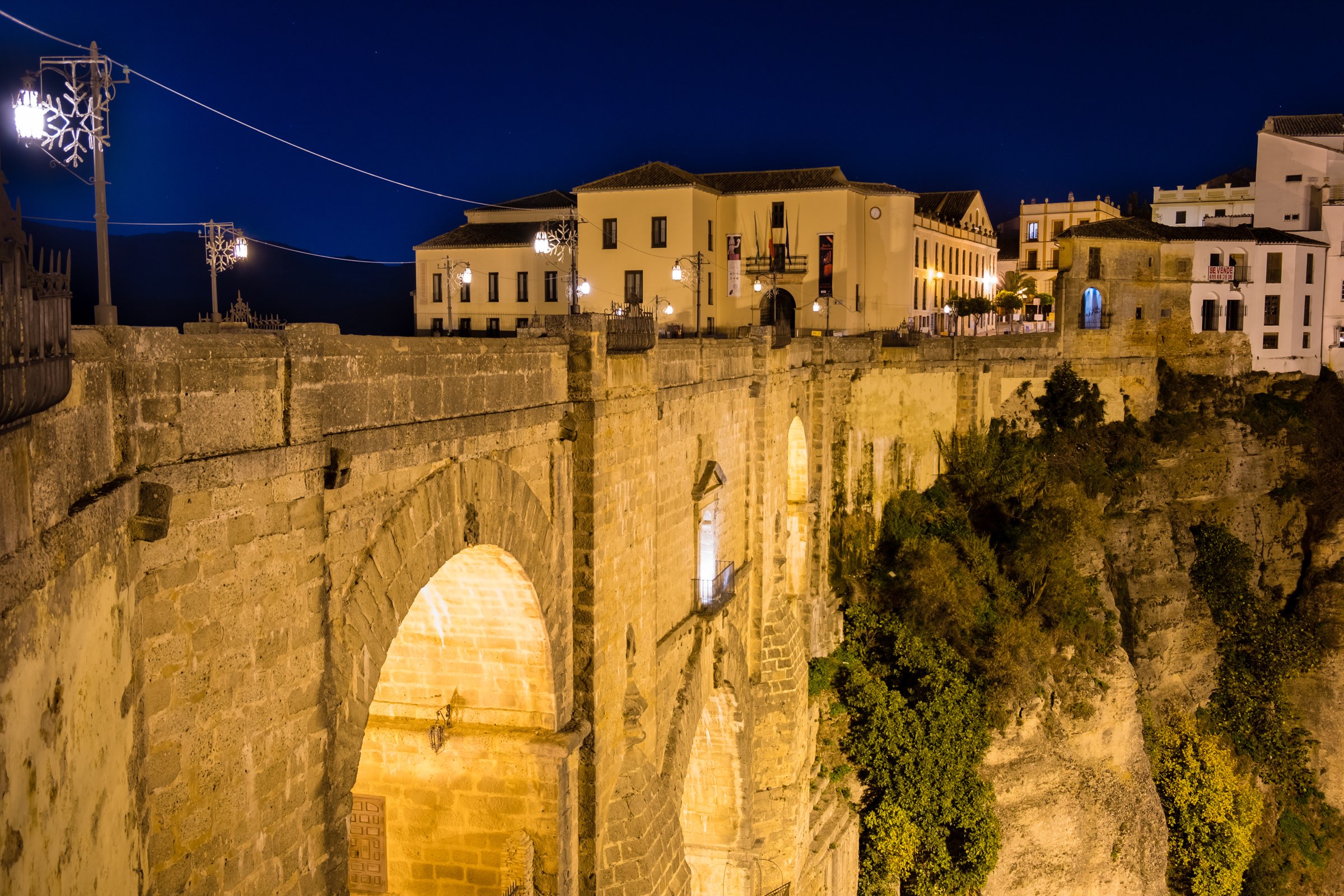
It’s been a long day and satisfied that I explored and witnessed as much as possible I head slowly back to our apartment and arrive home and just gone 12PM. I scuttle in to bed and fall asleep almost instantly.
Day two in Ronda
It’s our second and last day in Ronda so we plan on doing some more strolling around the streets with not as adventurous exploring like the previous day. A bit more relaxed. Later in the day we must catch the train to Algeciras, our final final destination in Europe. It’s not a place we want to explore, it’s where we catch the ferry to Africa from! Naturally we don’t want to stray so far from our means of transportation. And unfortunately hitchhiking is off the cards because we need to keep to a tight schedule.
With the aid of a beautiful art-deco styled tiled map of Ronda, we aimlessly walk around the streets. Rows of whitewashed houses lead to the peaks of the Sierra Nevadas. Geometric patterns and tiles surrounding shrines catch our eyes. An avid reader leaves finished books for the next interested passerby.
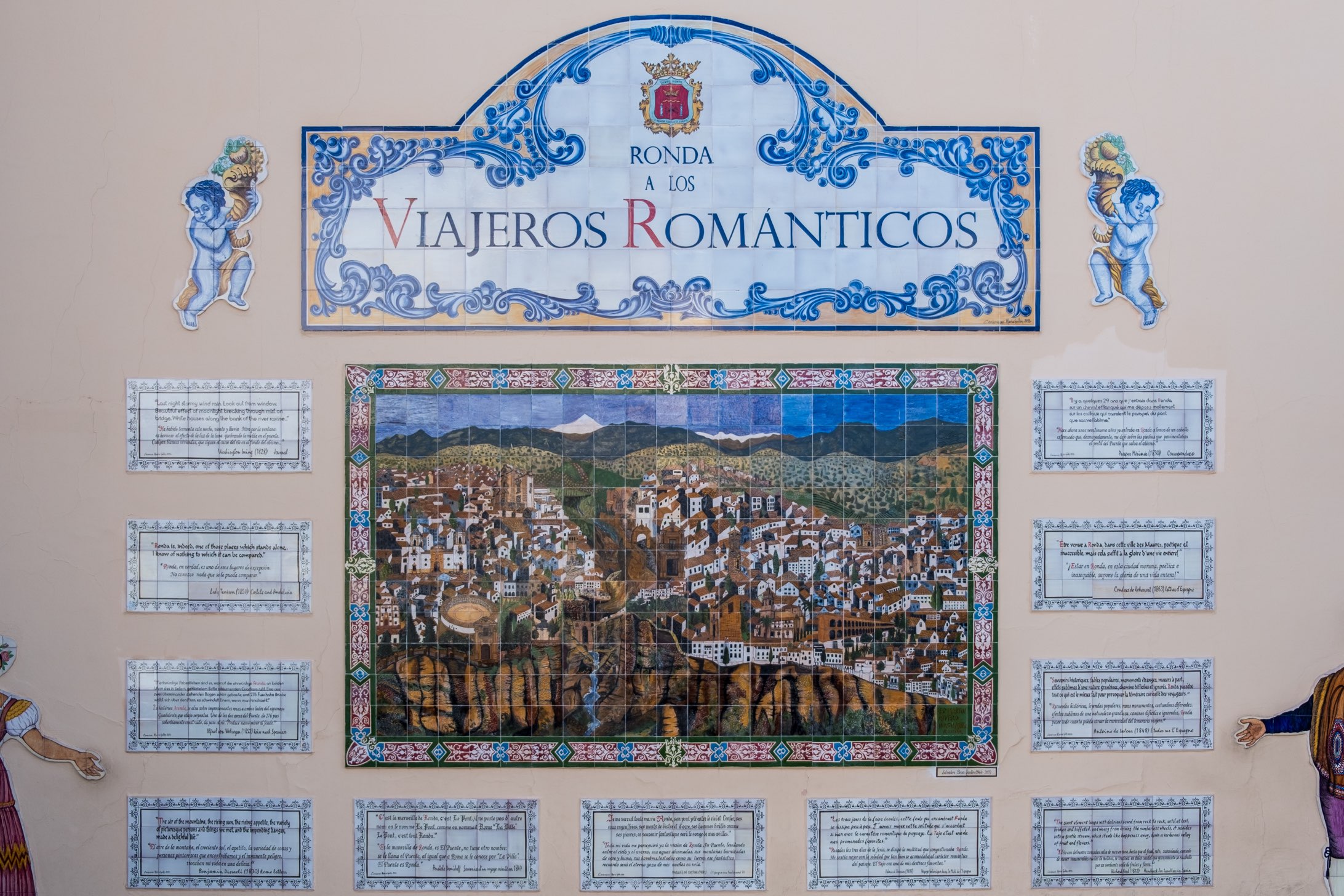
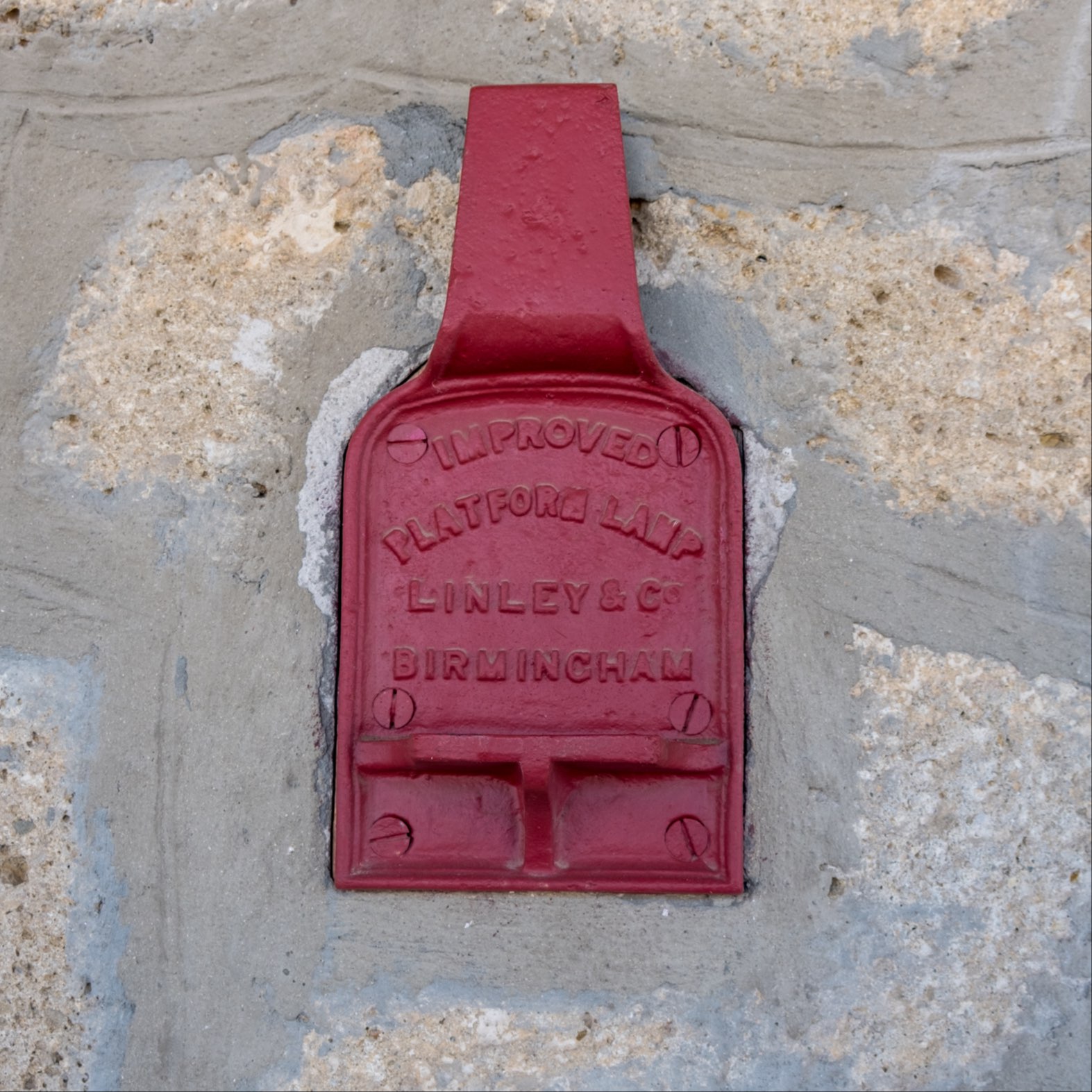
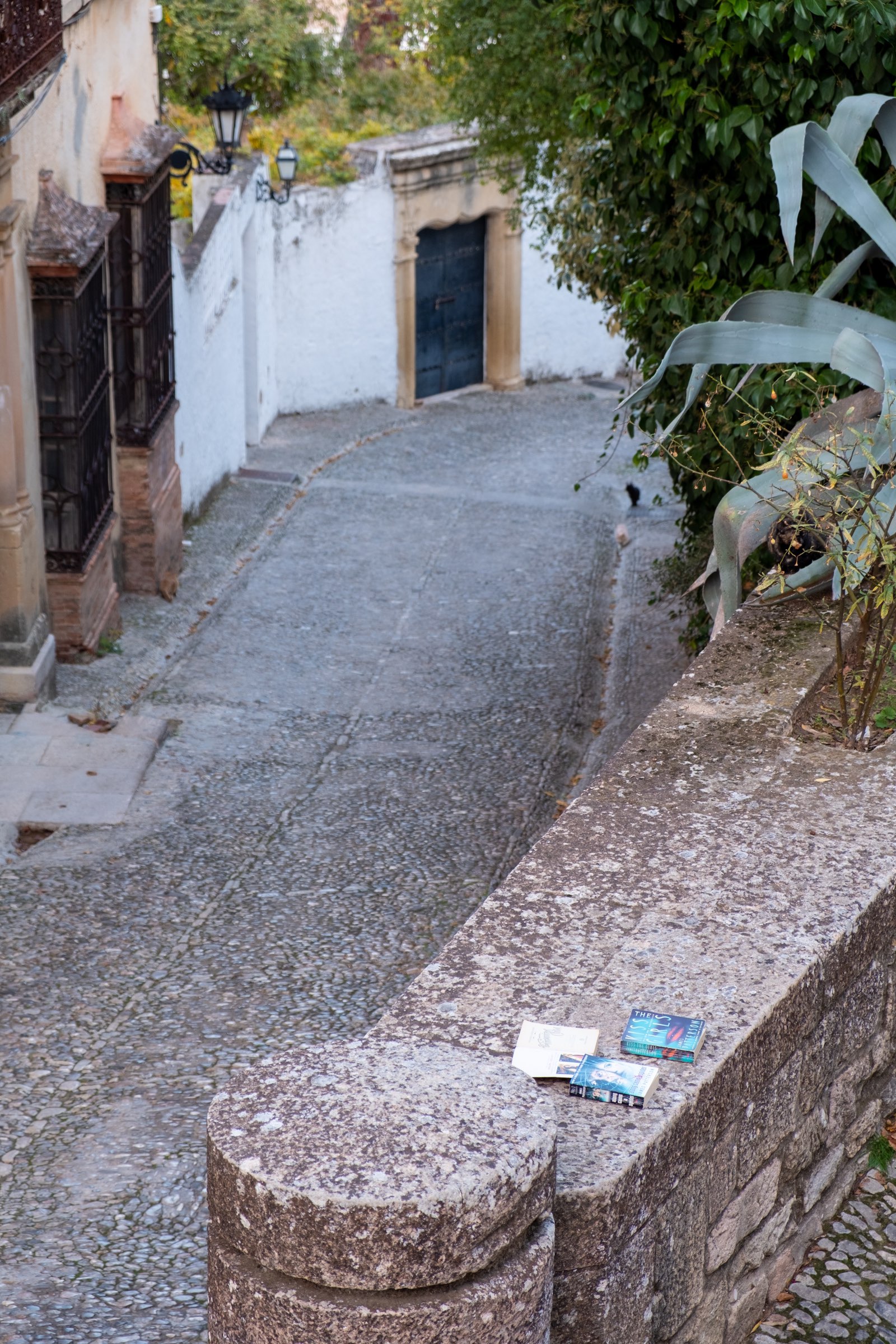
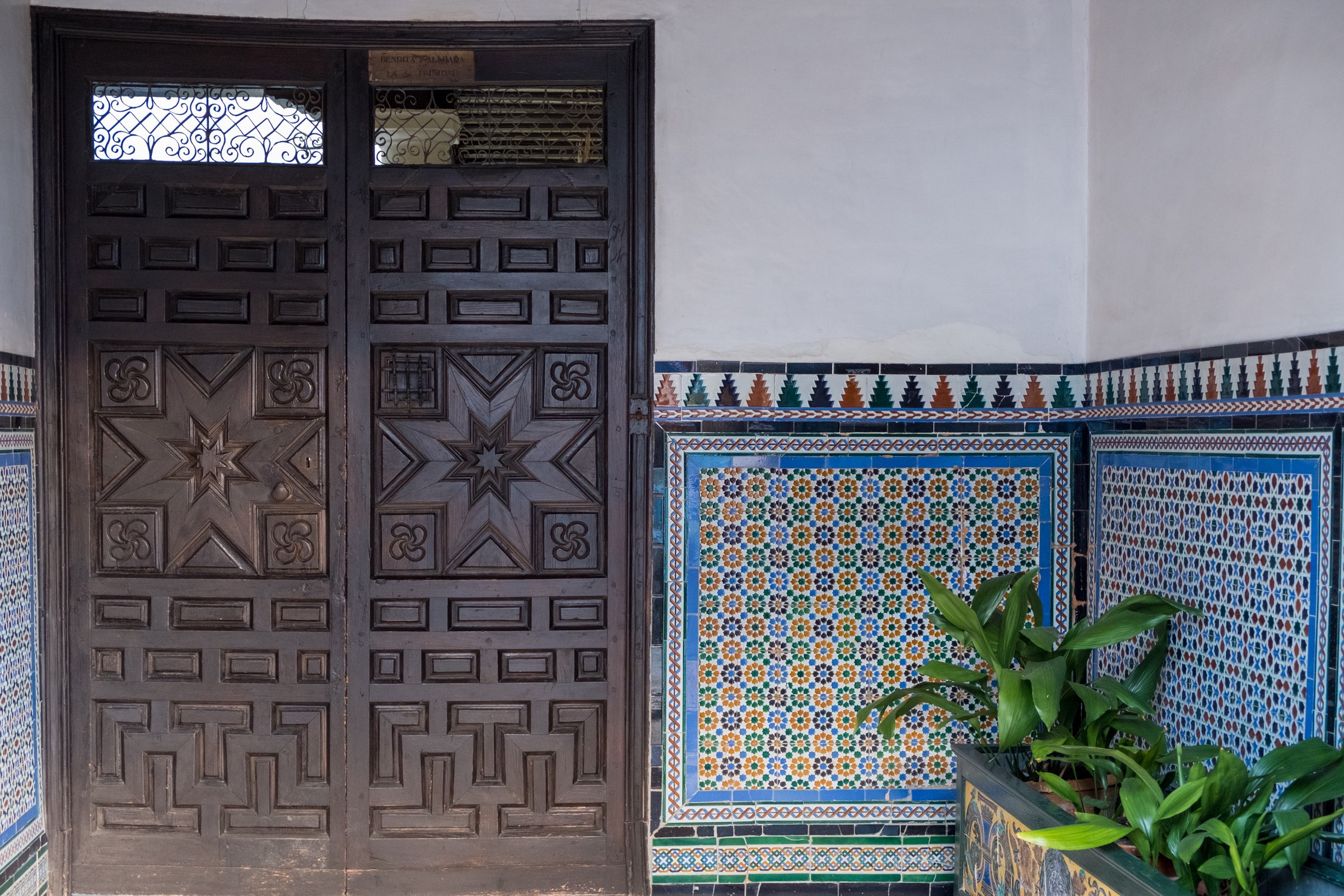
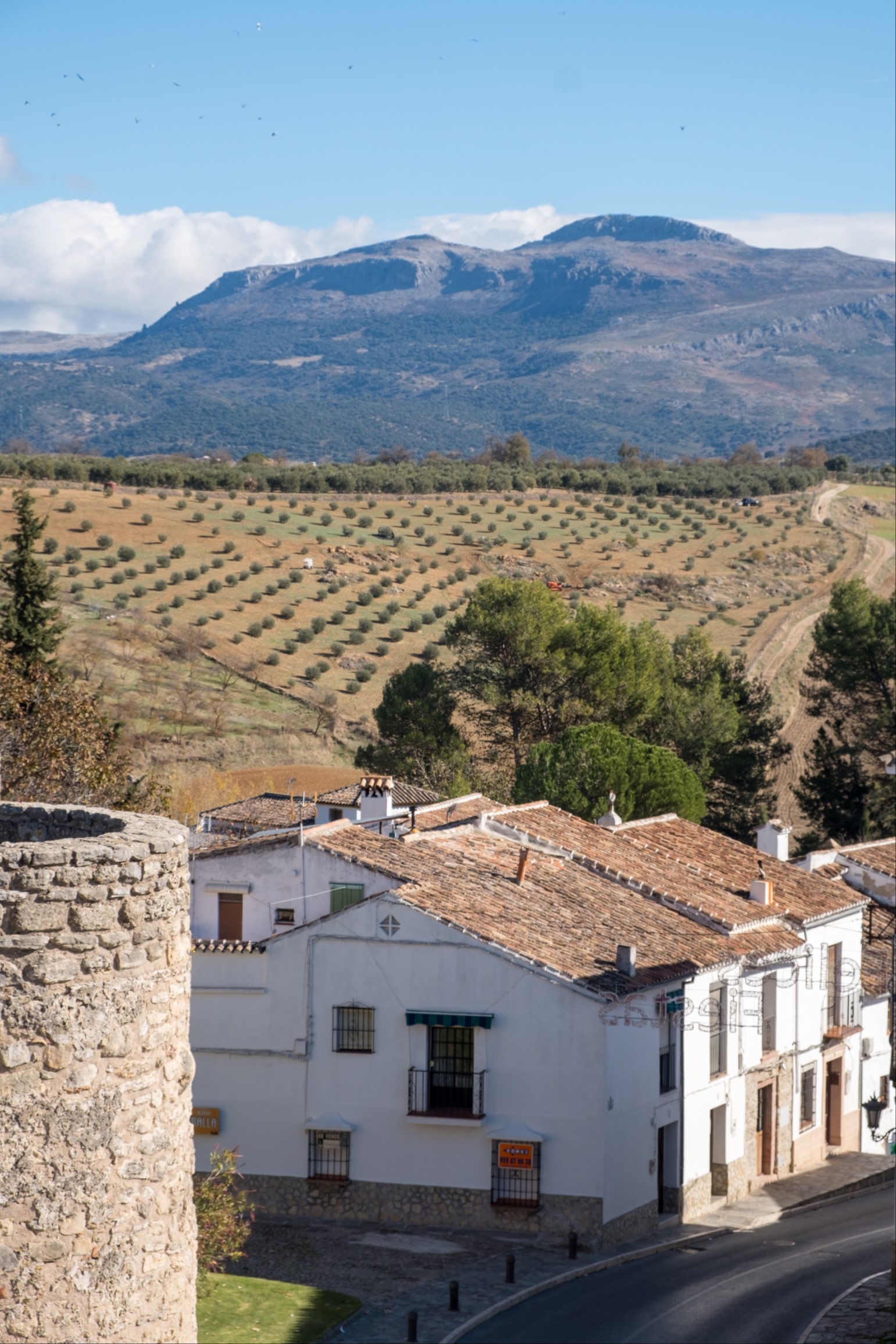
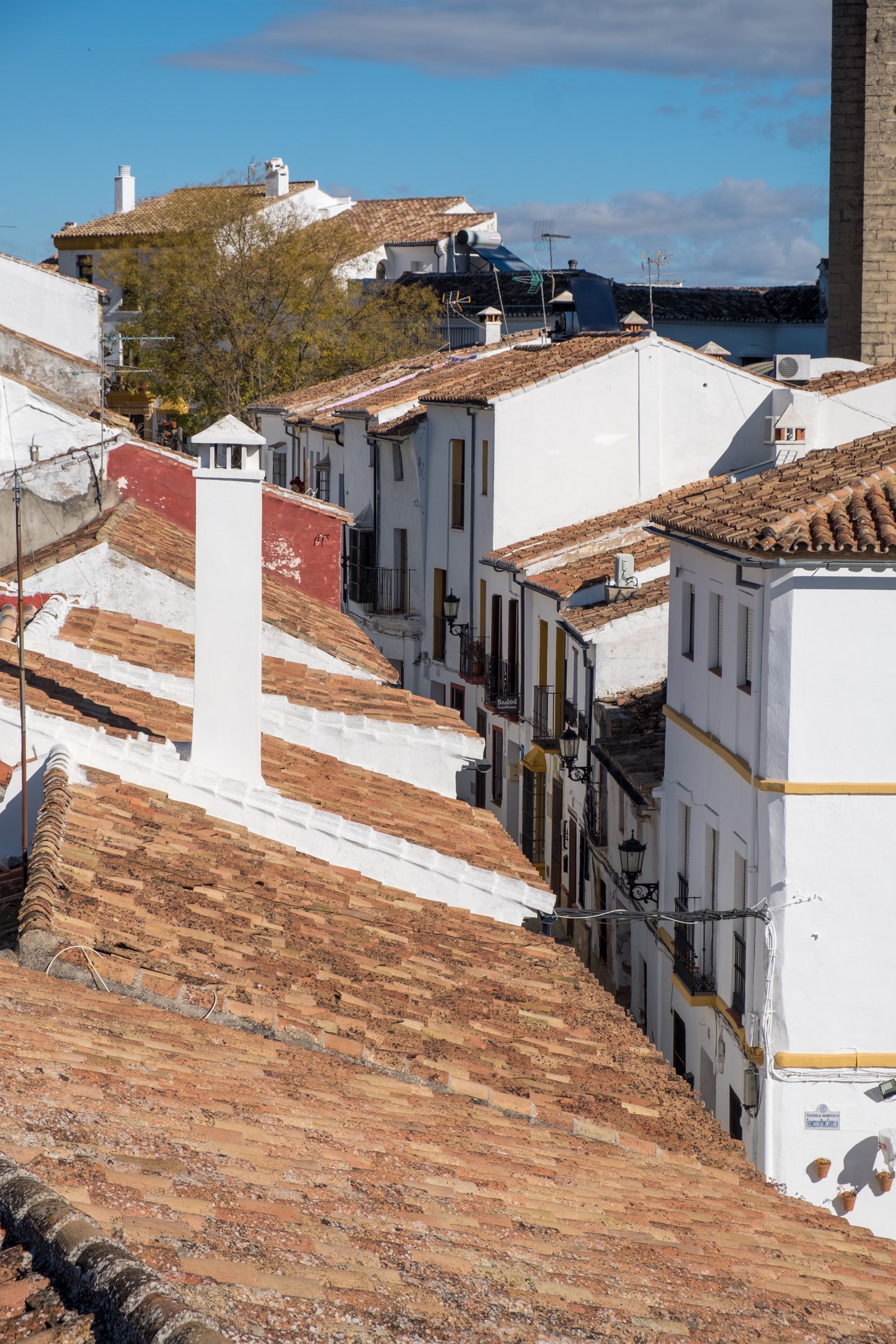
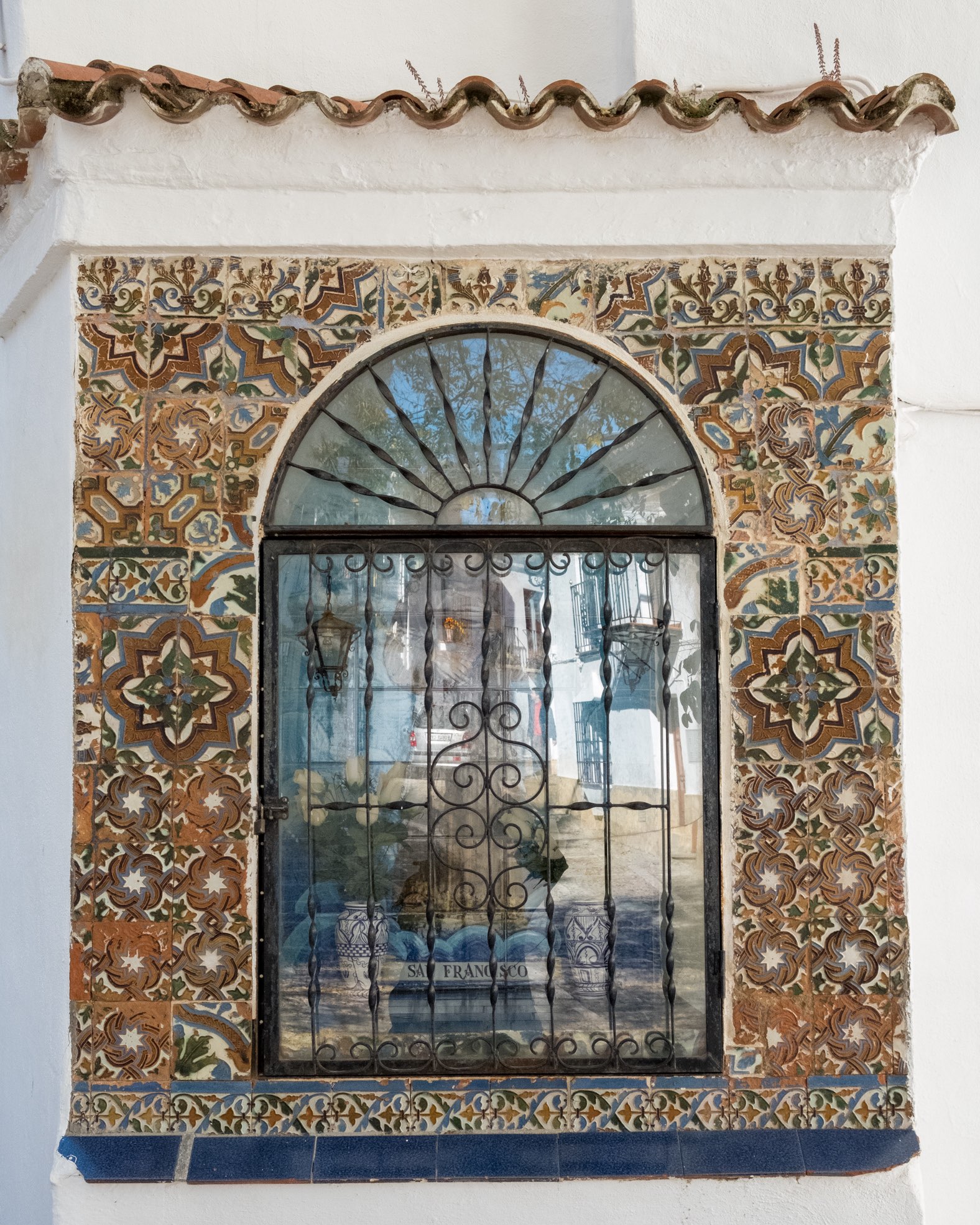
Puente Viejo & Ronda walls
We pass by the old bridge again, just below it the Arab bridge. A worthwhile visit is the nearby Arab baths. These baths, although not functioning, are the best preserved in the whole of Spain. Another piece of history you might want to visit is Plaza de Toros de Ronda, Ronda’s bullring. We are against animal cruelty and as such do not want to visit. If you’re intrigued, you should know It’s very important in Spanish history, read about it here. After we’ve explored the walls, taken photos of cool old Spanish dudes and hung out in the nearby gardens of Jardines De Cuenca. A new addition to the city, built in 1975, hanging over the Tajo gorge with fantastic views all around. However, it’s from here we spot our next target, La Casa del Rey Moro.
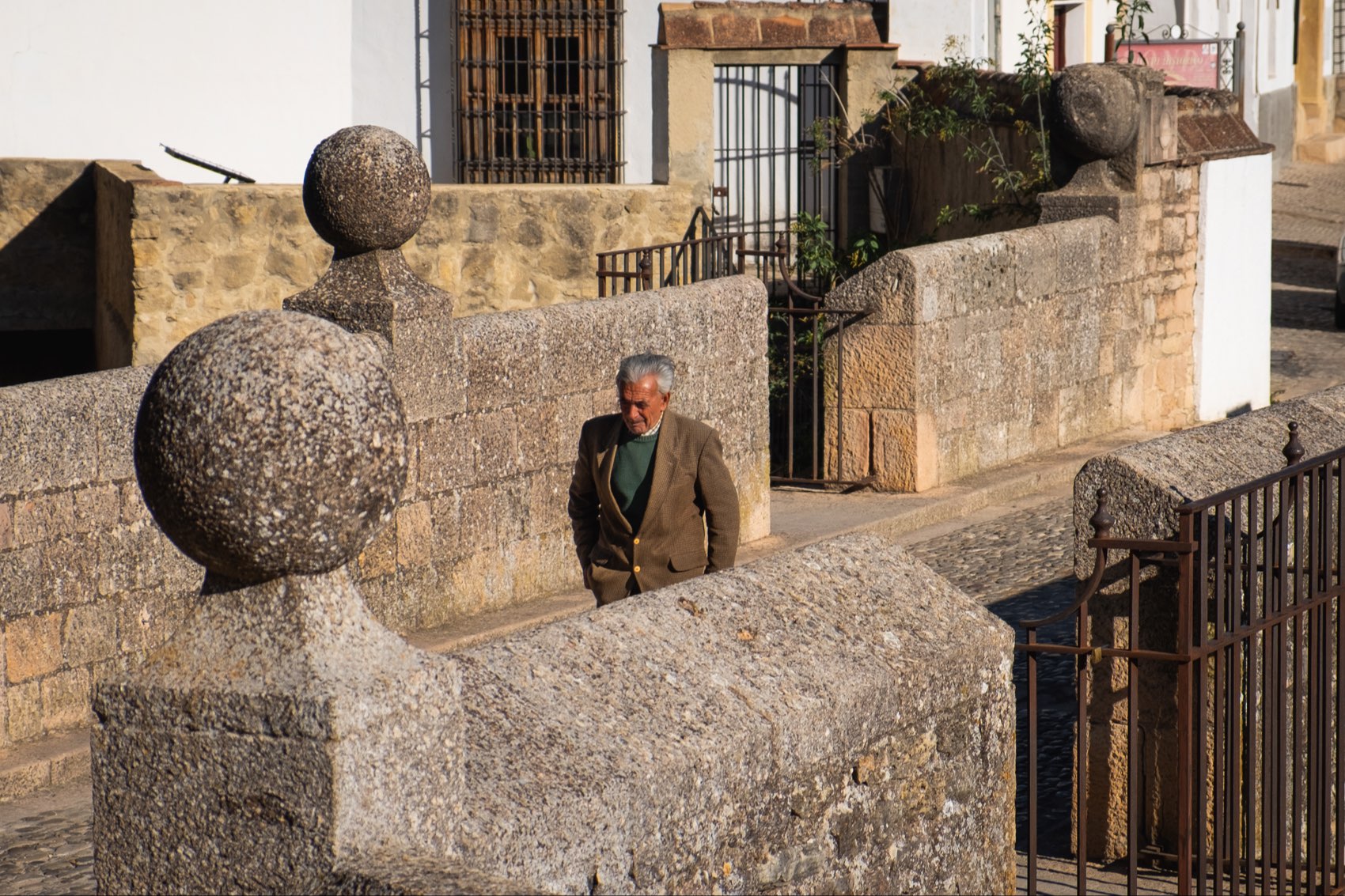
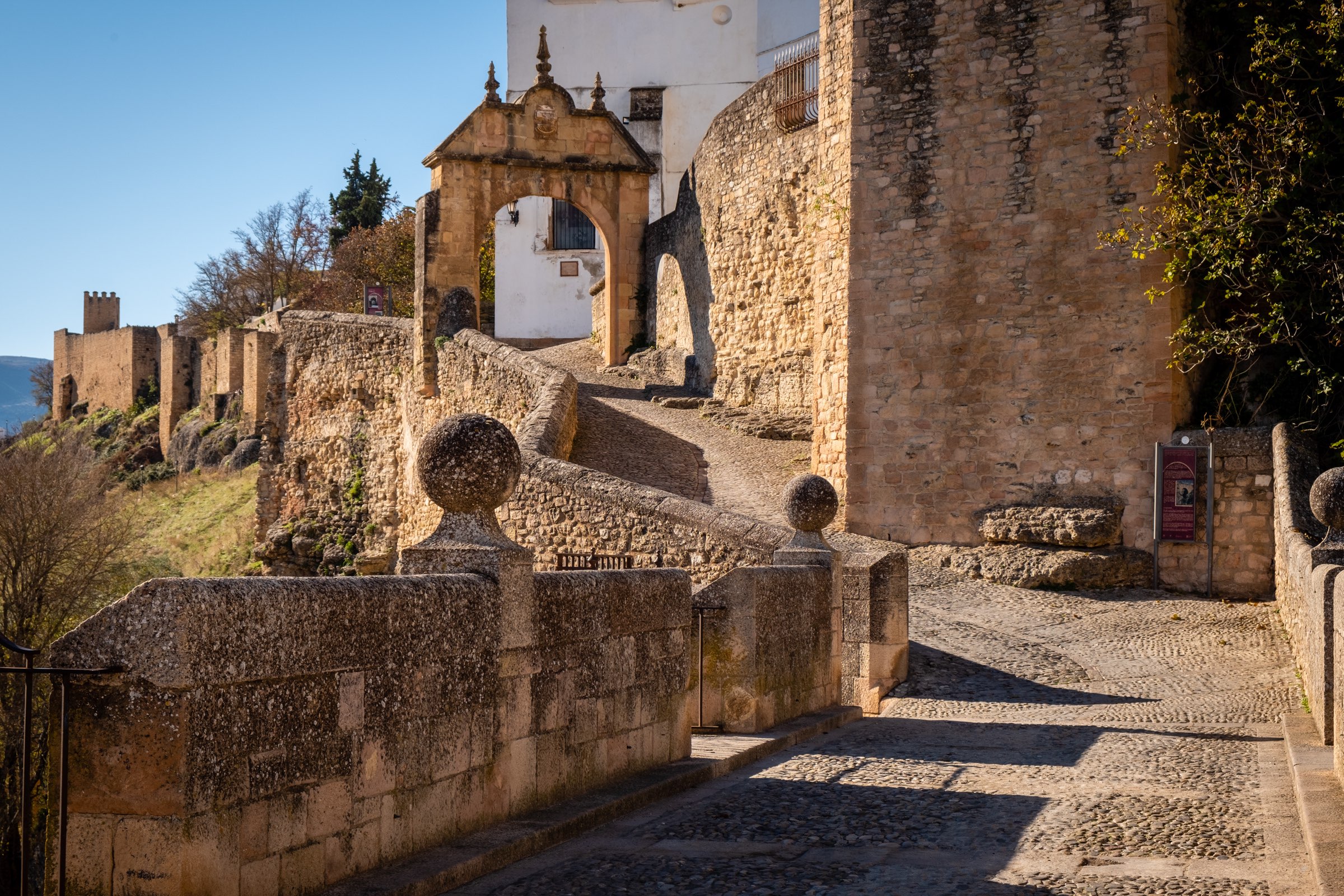
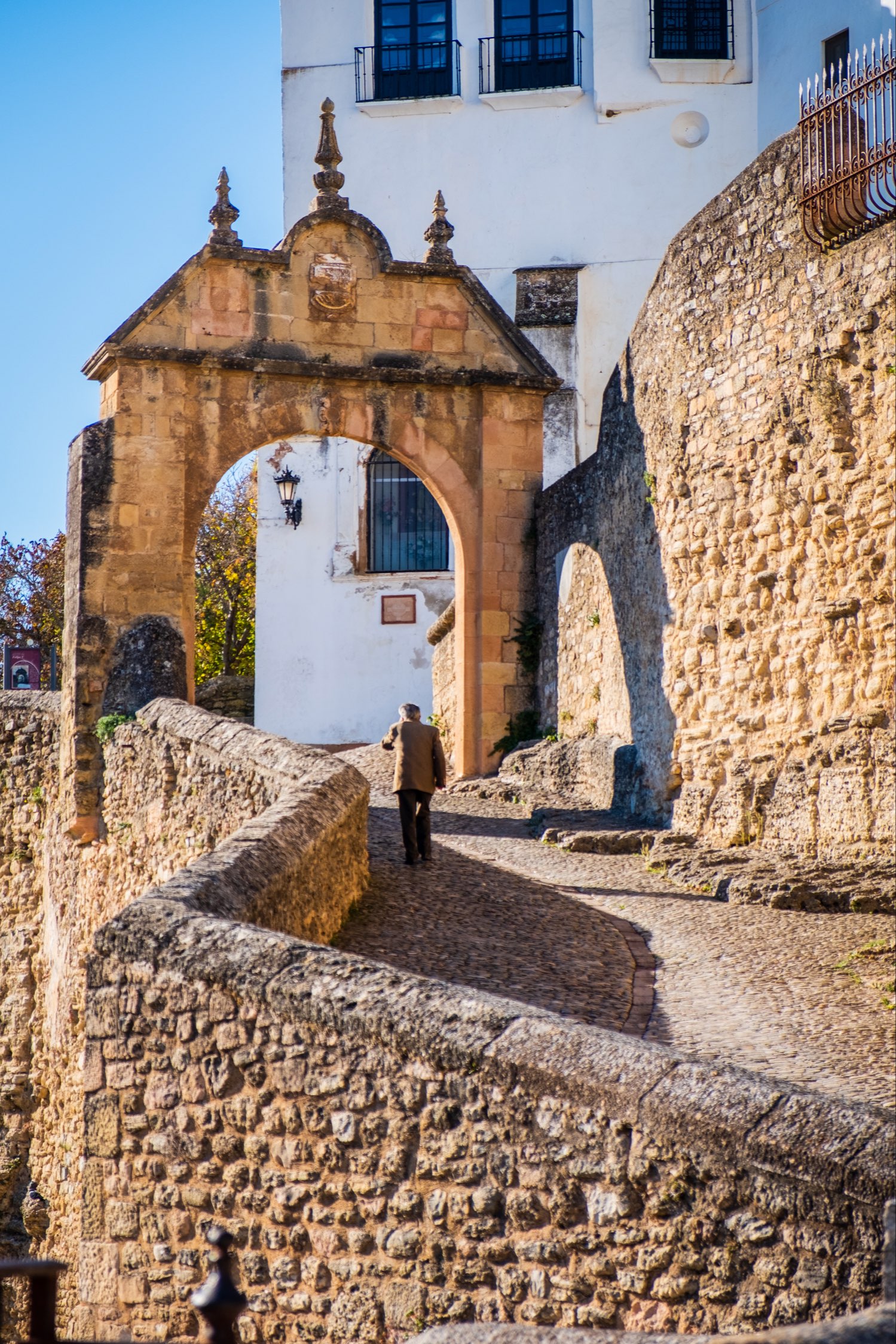
La Casa del Rey Moro
The house of the Moorish king, only it wasn’t, because it was built after the Moorish empire was defeated during the Christian Reconquista. It was built in the 18th century and the gardens, even more recently in 1912 by French landscape gardener, Jean Claude Forestier. The construction does include one important antique built by the Moors: the water mine. In the 14th Century, during the frequent Christian besieges, the Moorish king commanded the carving of steps in to the stones walls of the gorge. In order to supply the city with water. It was subsequently built by Christian slaves who came to know that in Ronda you die carrying water skins.
The stairs are very much accessible, though it is an arduous journey, with only one way back up. Three hundred dark and sometimes wet steps spiral down through the rock of Ronda, so take care when descending. At the bottom we emerge into the canyon by the river where the wooden boat was pictured earlier. But not before we pass through several chambers, one known as the room of secrets.
Finally, there are the gardens. As alluded to earlier, they are not truly Moorish gardens, but pretty nonetheless. Absolutely worth an explore. I spend the next thirty minutes trying to photograph a particular fine specimen of a Peacock against a backdrop of azure tiles. It’s seemingly harder to execute than expected although I’m quite fond of the result.
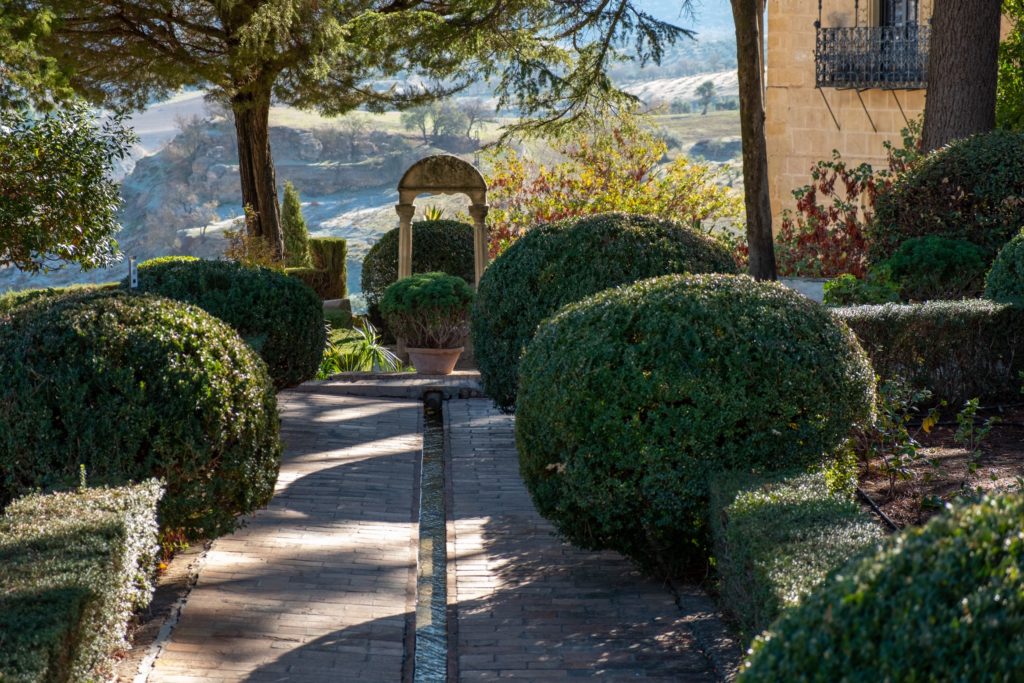
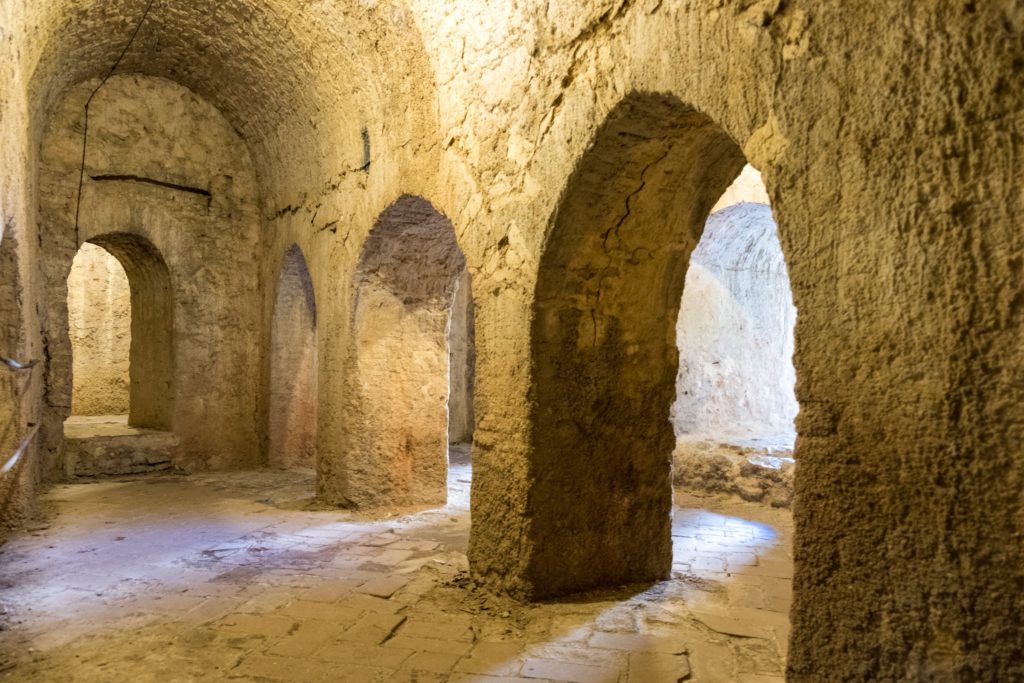
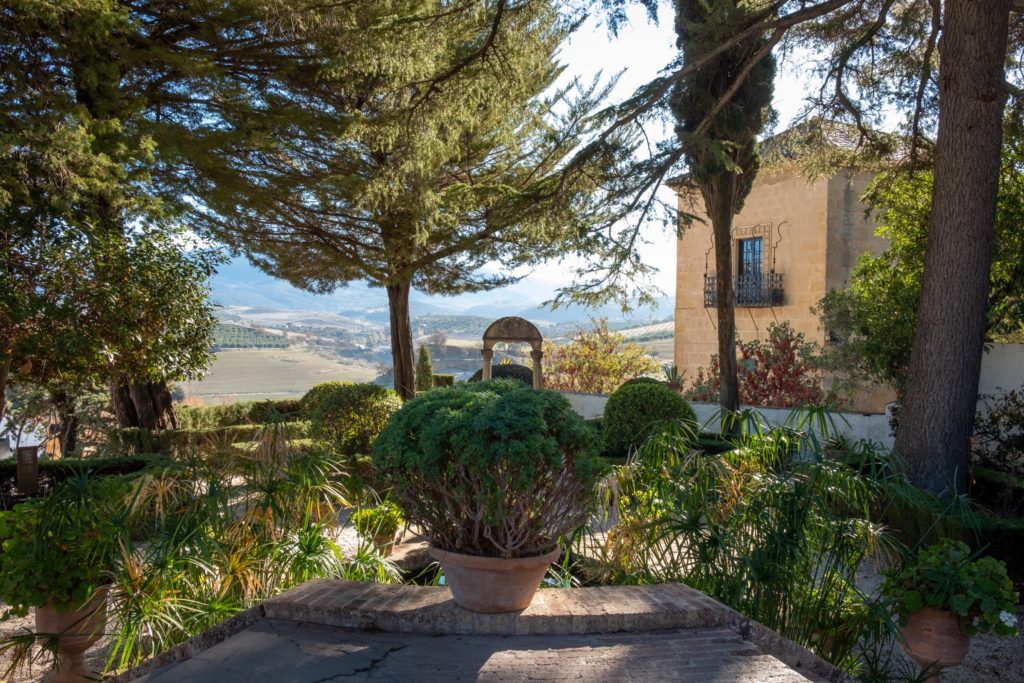
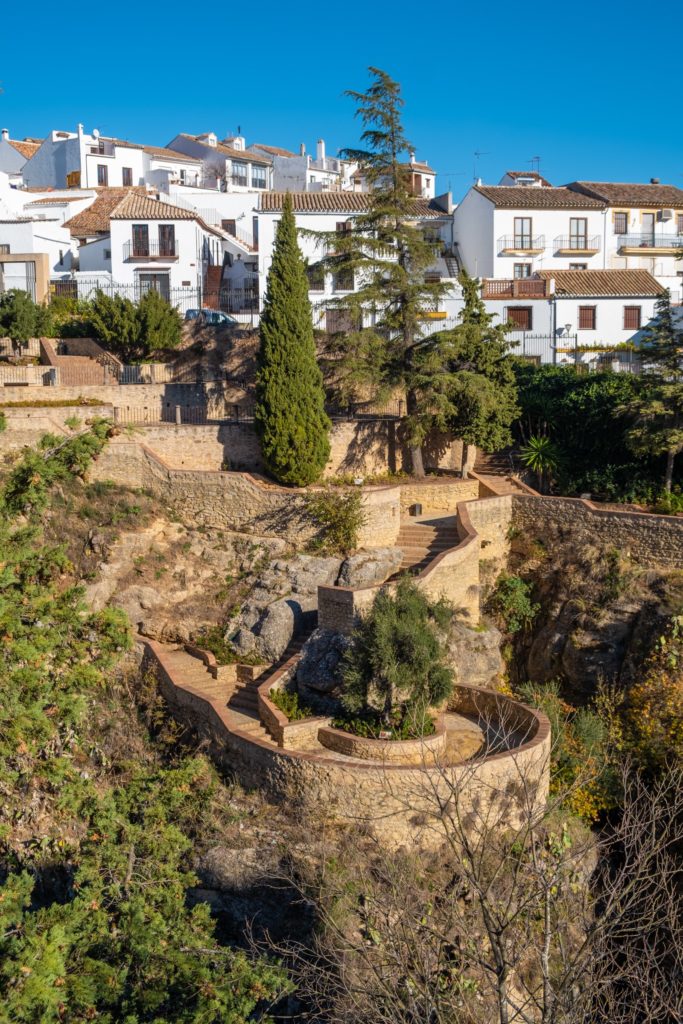
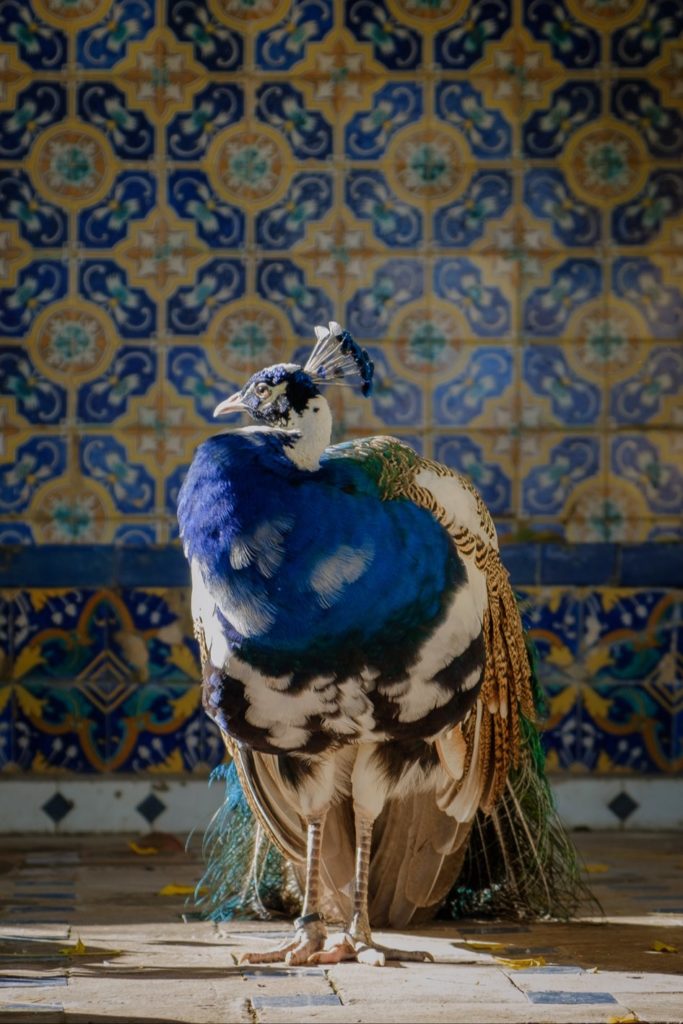
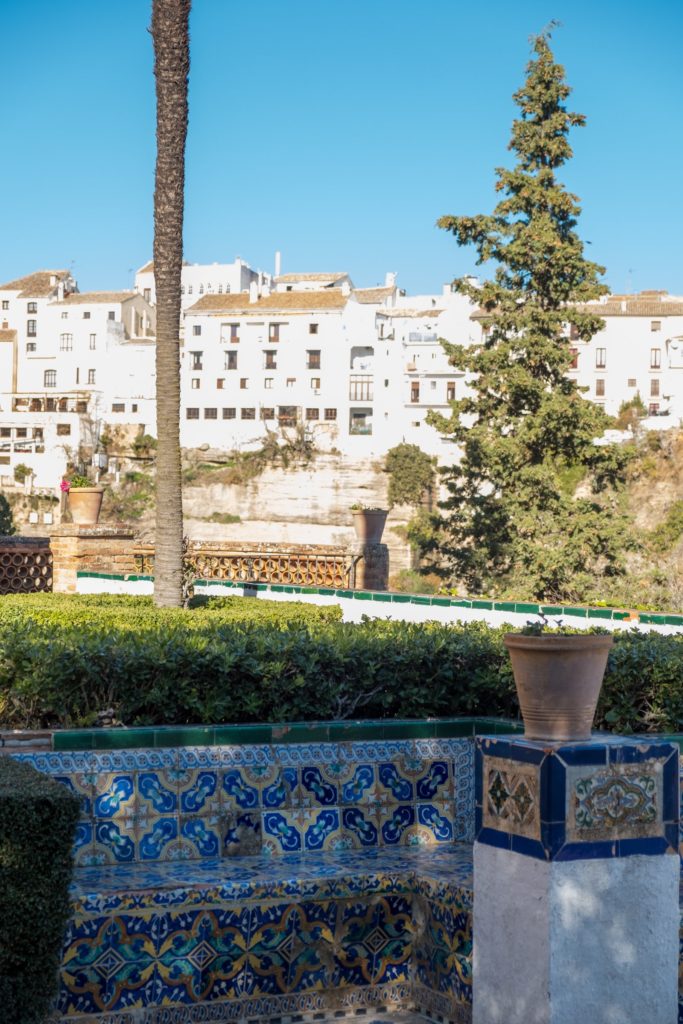
A bite to eat and it’s time to make our way to the train. We make our way to the apartment to grab our bags and head to the station. Direct to Algeciras along the magnificent railway chiefly constructed by British engineer John Morrison. It’s worth a ride for the impressive views of mountains, rivers and canyons!
How to get there
The closest international airport to Ronda is Málaga Airport. Check Skyscanner.
If you’re coming from a different city in Spain we’d recommend travelling by train. From Algeciras and Gibraltar the journey is magnificent. The easiest option, or the one with better connections will probably be via bus. Try Interbus & Avanza – It takes around two hours from Malaga.
What to do
- Hang out around the bridges – It’s what dazzled you in the first place, right?
- Explore some of the most beautiful white washed mountain villages (pueblos blancos) in the Sierra Nevada’s
- Visit Mondragon Palace for stunning Islamic architecture and gardens
- Visit the ancient city of Acinipo, 15KM outside of Ronda with a Roman amphitheatre
- The Bullring (Plaza de Toros)
- Casa del Rey Moro – The water mine and not Moorish kings palace
- Go explore whatever buildings you can, they usually have wonderful interiors: churches, museums, palaces etc.
- Hiking – There are lots of wonderful landscapes around Ronda and therefore hiking opportunities must be extensive. However, we can’t seem to find any good articles so we won’t link any here. Try looking for some books or contact the tourist information centre.
- Hang out in the public viewing platforms and gardens, see the main article for more details.
Accommodation
We stayed in a little Airbnb out of town with cooking facilities. It was cheap and cheerful and the owner was very kind.
Pro Tip
- Hike from Ronda to the Cave shrine of the Virgen de la Cabeza and witness the splendid views over Ronda and the bridge of fantasies.
- Look for accommodation somewhere in old town, preferably with a rooftop terrace. Enjoying the view of the old town with the towers, spires and mountains must be incredible.
